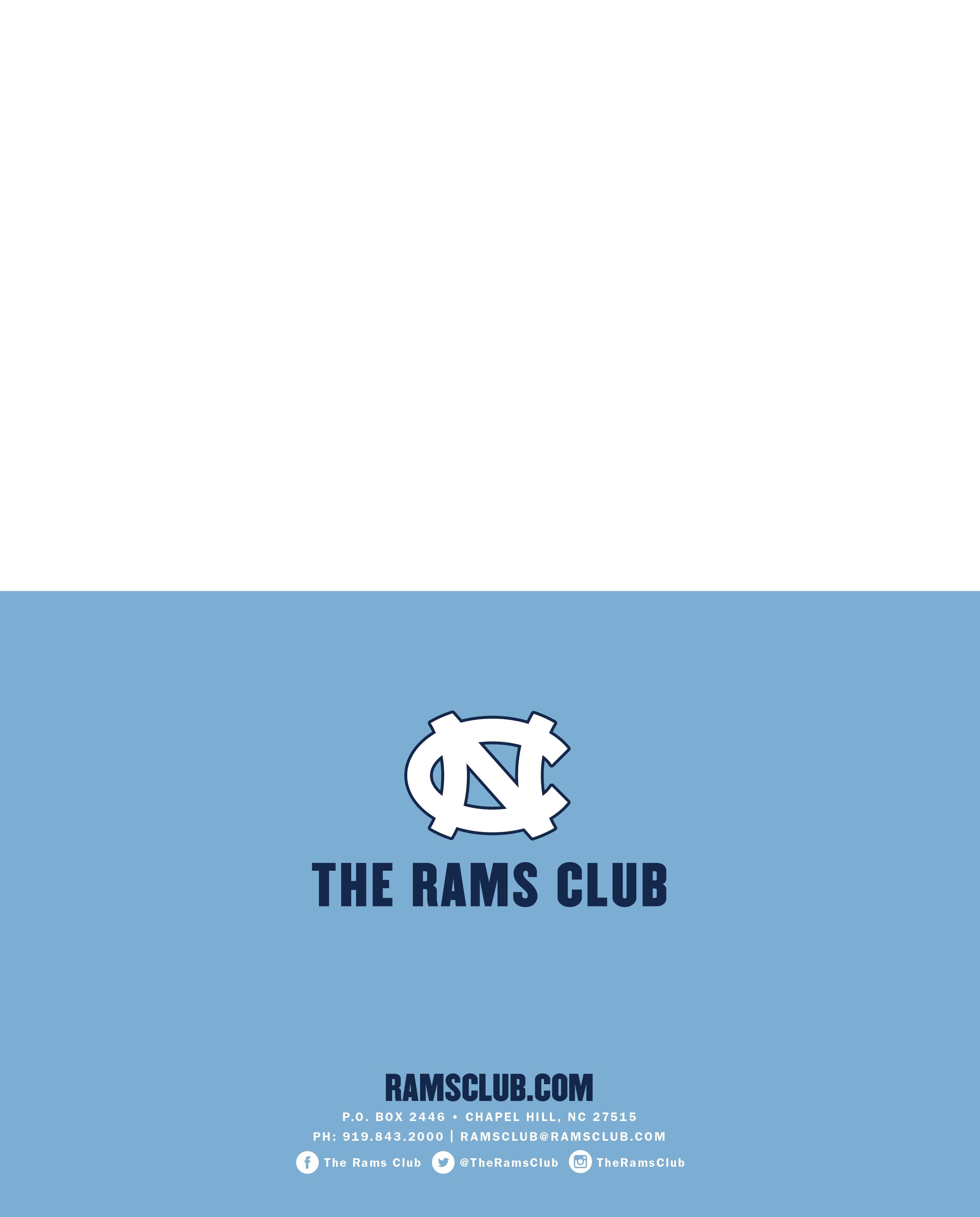










A little behind the scenes knowledge: this issue began as almost a joke.
As we were discussing future issue themes, creative wizard Julianne Hoell said, “We should do a Halloween issue!”
We chuckled. And then we started listing all the incredibly fun things that happen in Chapel Hill around Halloween.
There’s the holiday itself, of course, and the sheer unpredictability of having no idea what you might see on Franklin Street between October 30 and November 1. And it helped that the Tar Heel football team boasts Kaimon Rucker, a player with a very scary nickname—but a less than scary life outlook, as you’ll read in this issue’s first person column—who is having a breakout season and was a perfect candidate for a cover spot.
Halloween is fun even if you’re not on Franklin Street, and every year we hear from legions of Tar Heels who give their holiday a Tar Heel twist. Whether it’s a pumpkin carved with a Carolina theme to a UNC-centric costume, Tar Heel fans have a way of making sure their favorite team is included in all their festivities (and don’t forget to send pictures of your efforts this year to @TheRamsClub on Twitter and Instagram).
But even if you’re not big on tricks or treats—maybe you’ll feel differently about tricks after reading Lee Pace’s breakdown of the importance of trick plays—this season is undeniably a glorious one in Chapel Hill. The weather is often perfect, starting with that slight chill in the mornings but peaking in roll-the-windows-down warmth in the afternoon. Bonus points for no pollen when you’re getting that outside air, which is why fall will always be superior to spring. Venture down I-40, and there’s the State Fair, with rows and rows of food you’d never eat other than for ten glorious days in October. Those with long memories will recall that in years when Carolina played at NC State in football, that game was played during Fair weekend. That tradition was discontinued when everyone realized that voluntarily creating the worst traffic jam on the East Coast every other year was a very bad idea.

And besides, fall means football Saturdays in a much more special place—Kenan Stadium. This year’s Tar Heel football schedule provided three October home dates, just the third time that’s happened in the last decade. That’s three BLTs at Merritt’s, three strolls down Franklin Street to buy that day’s “Beat _____” button, and three drives up Raleigh Road into campus marveling at the changing leaves.
As we started to total up the best parts of the weeks around Halloween, what had once been a half-joke turned into something worth serious consideration, and now you have the product of those discussions in your hands.
Happy fall—and Happy Halloween—from everyone in Chapel Hill. And don’t forget to give out the good candy this year.
 Adam Lucas Editor in Chief
Adam Lucas Editor in Chief

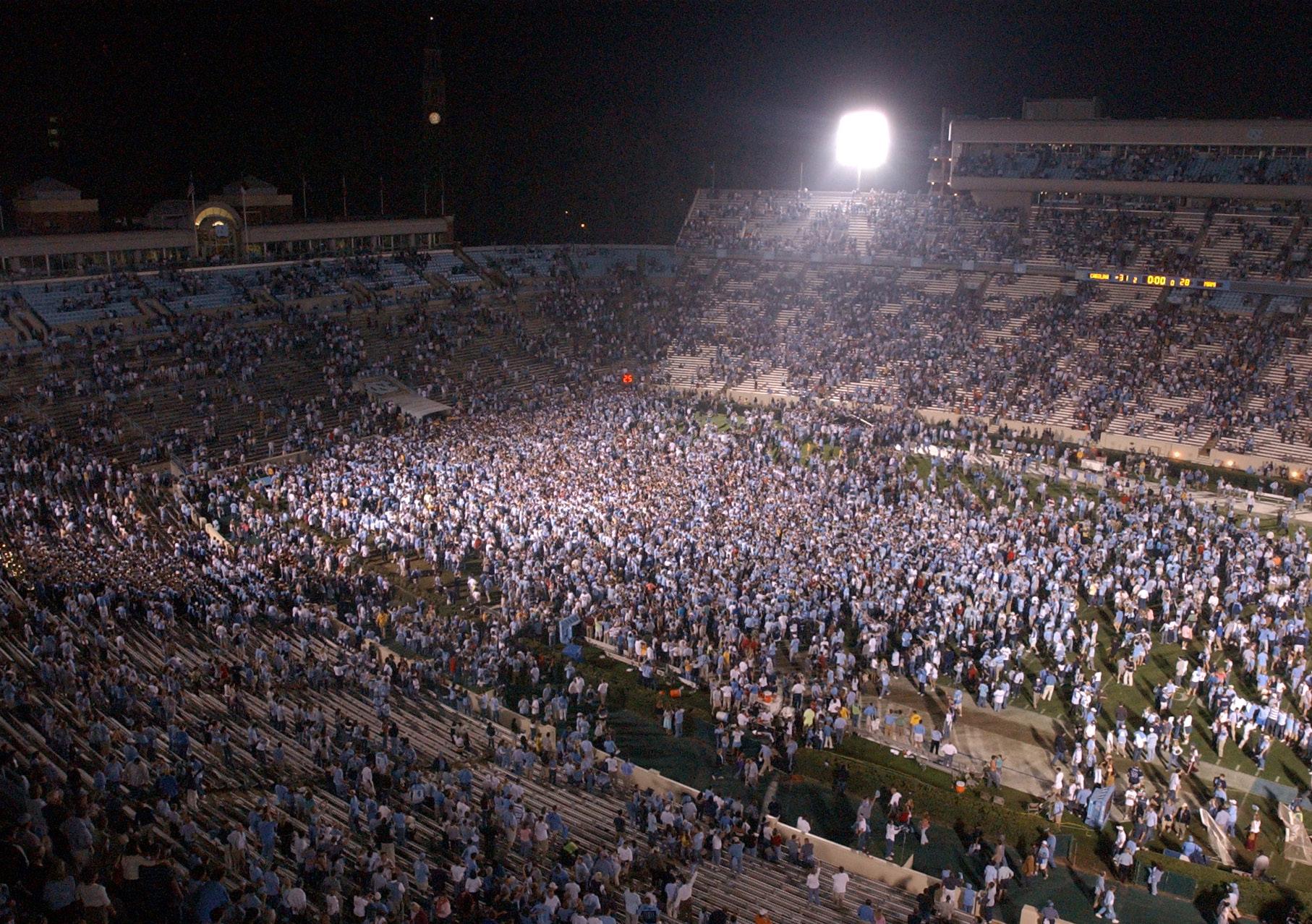
— HENRIK RODL AT THE OCT. 30, 1992 MIDNIGHT MADNESS “
ON THE COVER:
Kaimon Rucker goes by “The Butcher” on the field, but only opposing quarterbacks should fear him.
COVER IMAGE IN COLLABORATION WITH JEFFREY CAMARATI
COTA (OPPOSITE): ALLSPORT
“This team is going to be scaaaaaary.”


26
EDITOR’S LETTER p. 3
TAR HEEL HALLOWEEN
32
TAR HEEL TICKER p. 6

34
CAROLINA EVERYWEAR p. 28
TAR HEEL HALLOWEEN
Fall in Chapel Hill means some of the best Carolina has to offer
BY ADAM LUCAS TAR HEEL HALLOWEEN14 The Tricks are Treats
Tar Heel football has a rich history with utilizing trick plays—and occasionally stopping them
BY LEE PACE TAR HEEL HALLOWEENTar Heel games don’t frequently mix with Halloween, but when they do it’s often a memorable result
BY ADAM LUCAS TAR HEEL HALLOWEENA rogues’ gallery of the opposing players and coaches Tar Heel fans have loved to cheer against
BY ADAM LUCASFour Tar Heel teams boost Children’s Hospital with Halloween tradition
PHOTOS BY UNC ATHLETIC COMMUNICATIONS
TAR HEEL HALLOWEEN
Some Tar Heel point guards have been masters of illusion
PHOTOS BY ADAM LUCAS
TAR HEEL HALLOWEEN
Don Curtis and his family have touched virtually every corner of Carolina, including his beloved Kenan Stadium
PHOTOS BY ADAM LUCAS
FIRST PERSON
Kaimon Rucker has a very simple goal for his time in Chapel Hill: leave it better than he found it--on and off the field
BY KAIMON RUCKERFor this month’s magazine, we asked Rams Club members to tell us about their favorite fall activities in Chapel Hill and Tar Heel Halloween traditions.
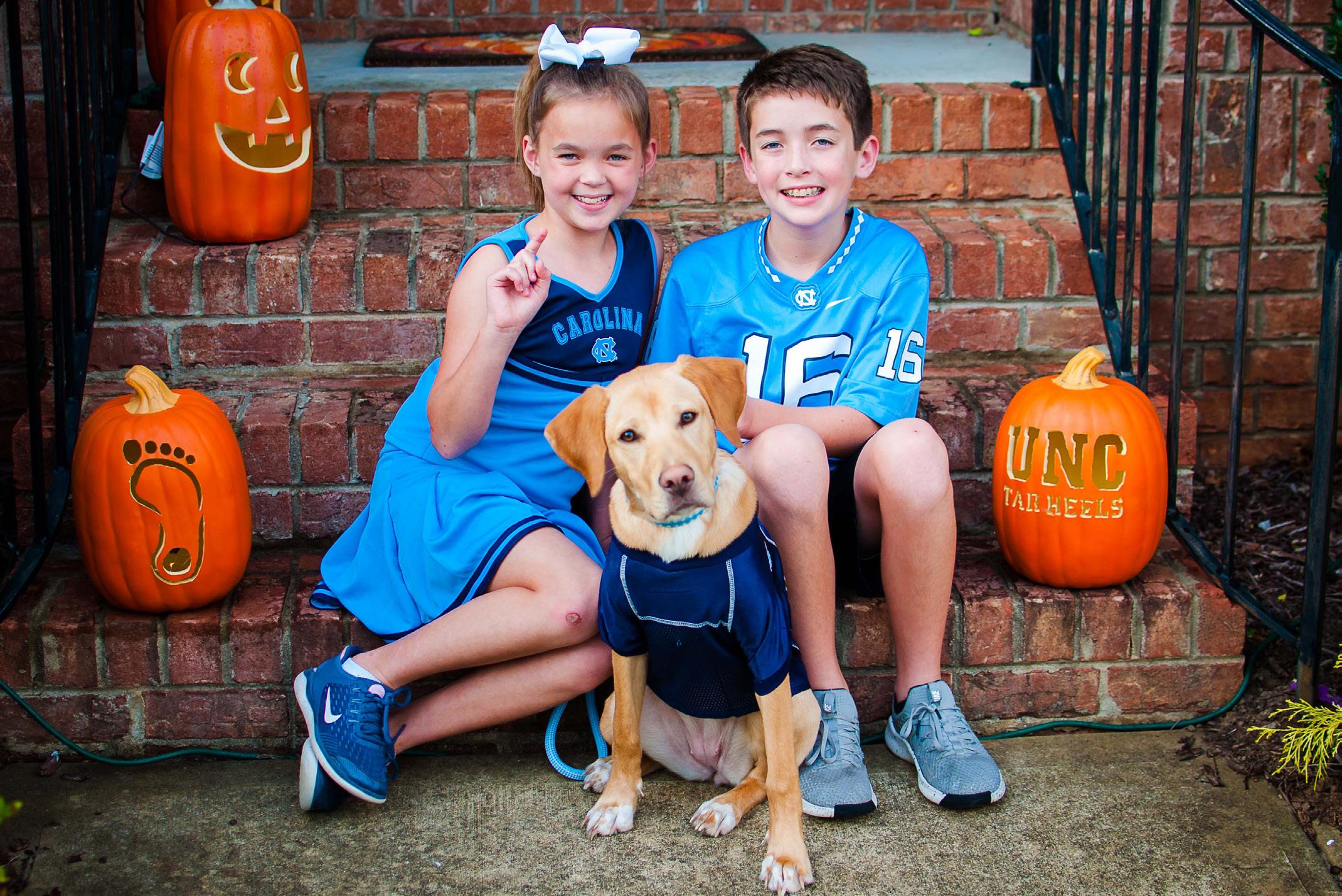

Our quintessential fall activity for Chapel Hill is visiting Spring Haven Farm in Chapel Hill! So many fall adventures with the farm animals and tractor rides! This is Jameson (our son who is also a Kids Club member!).
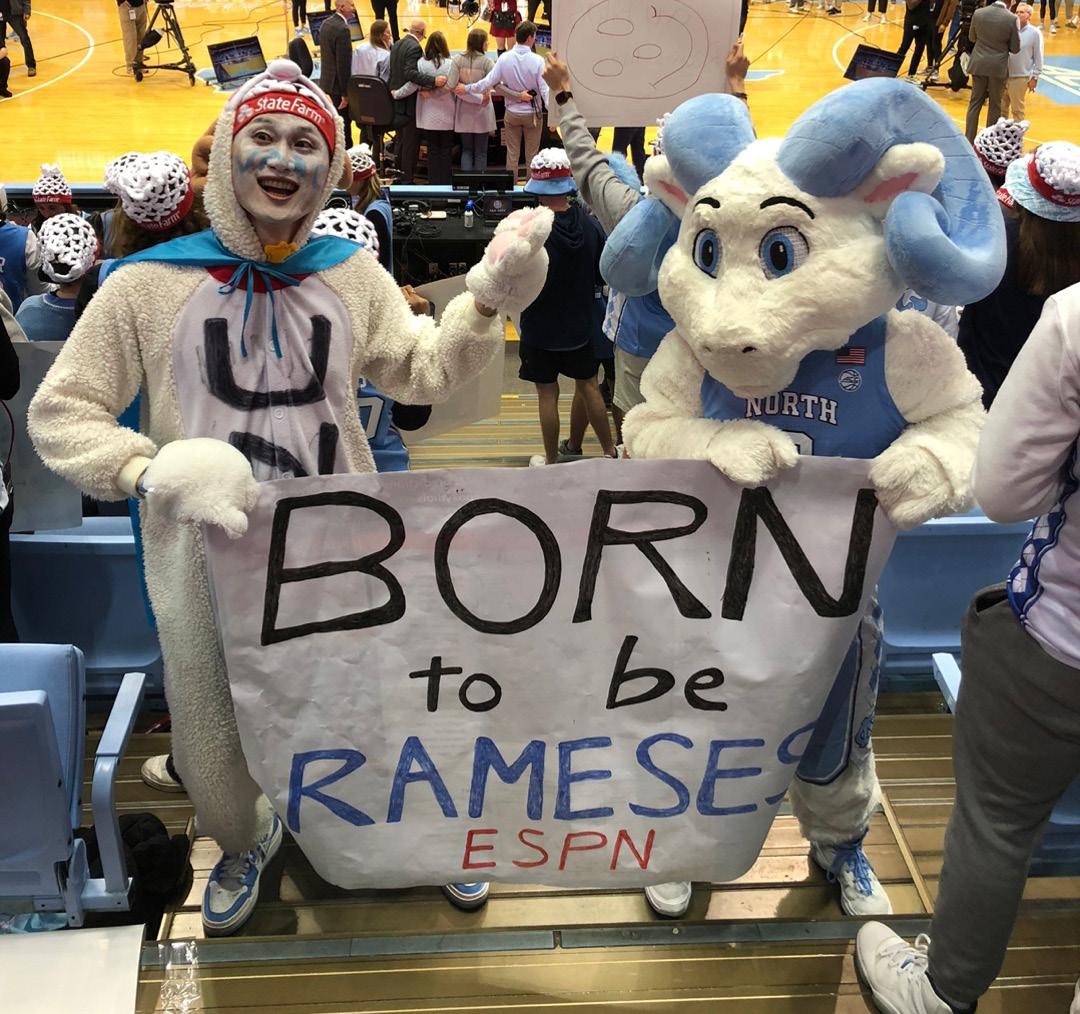
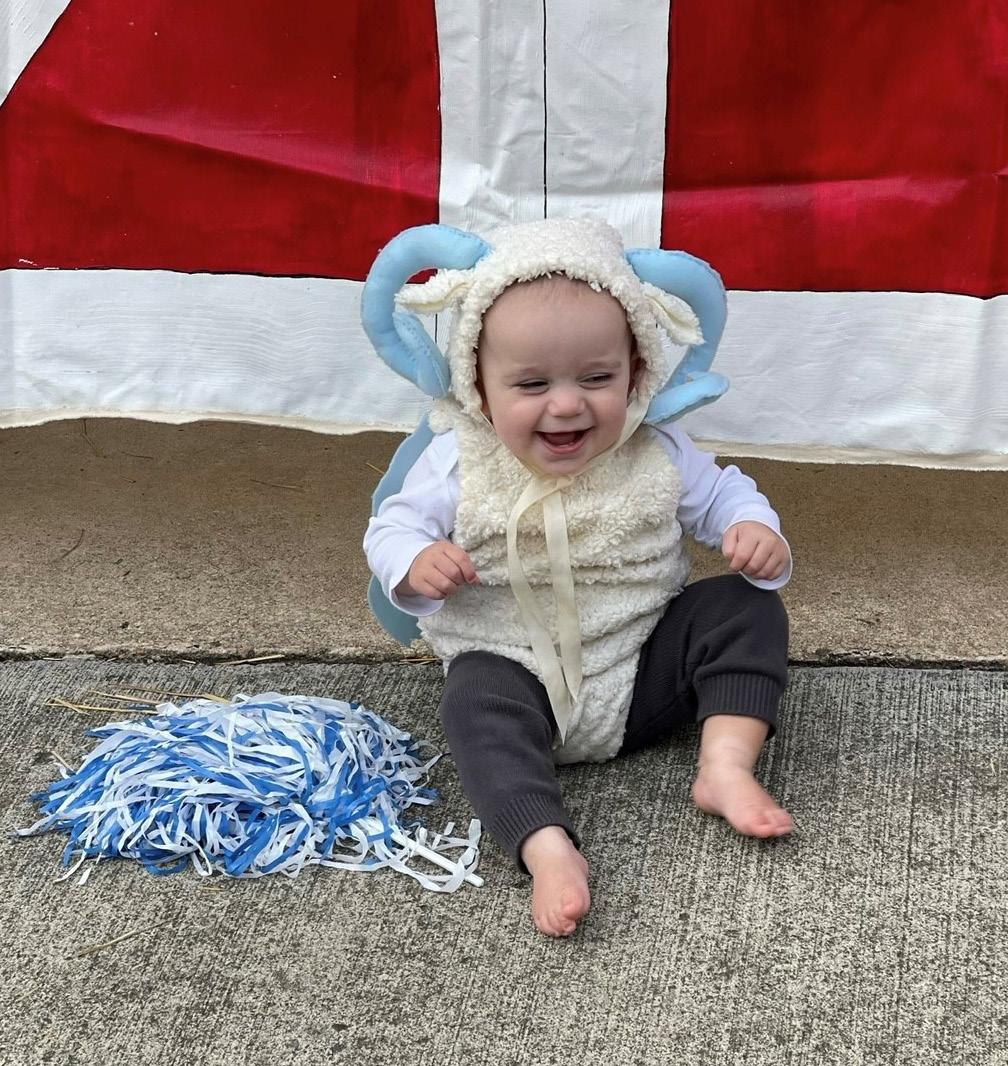
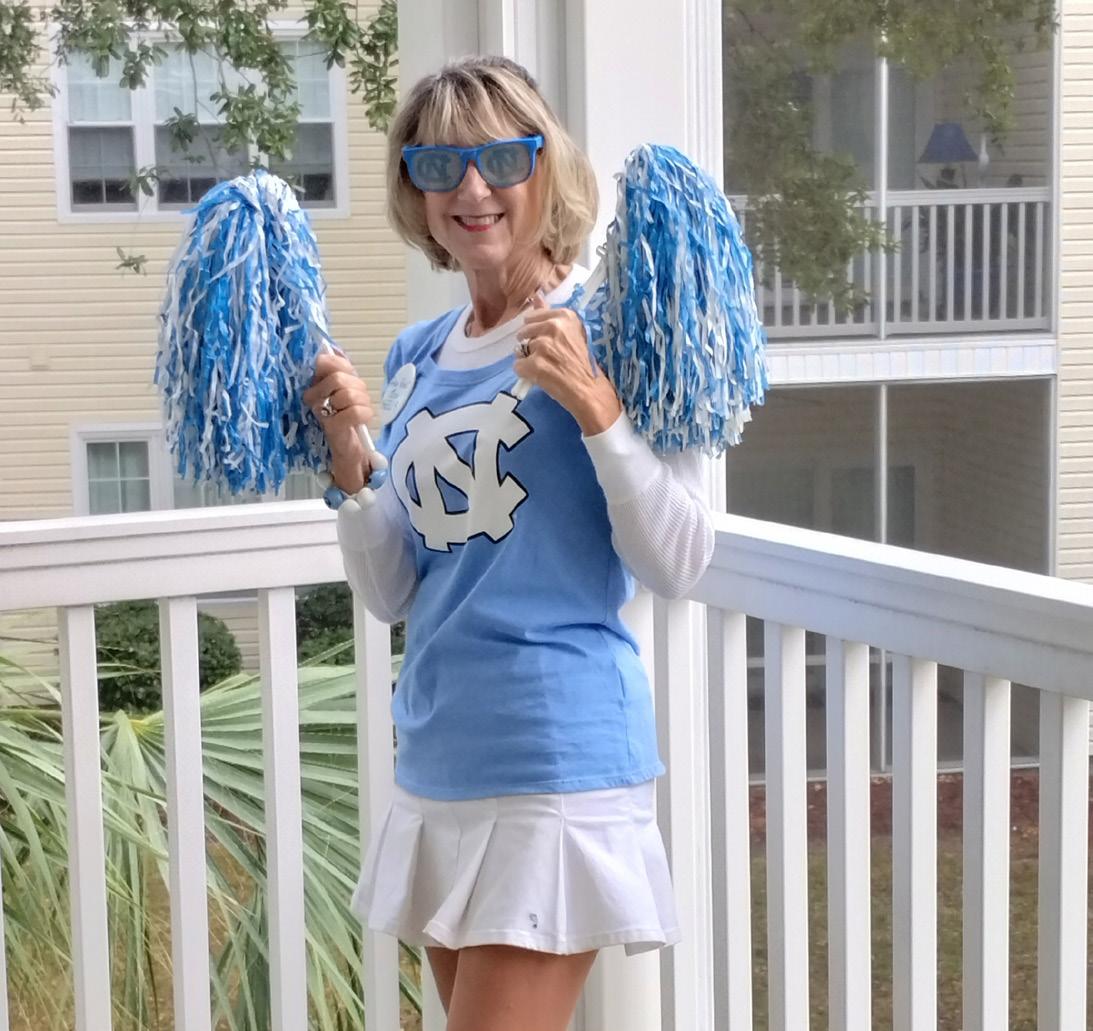
I
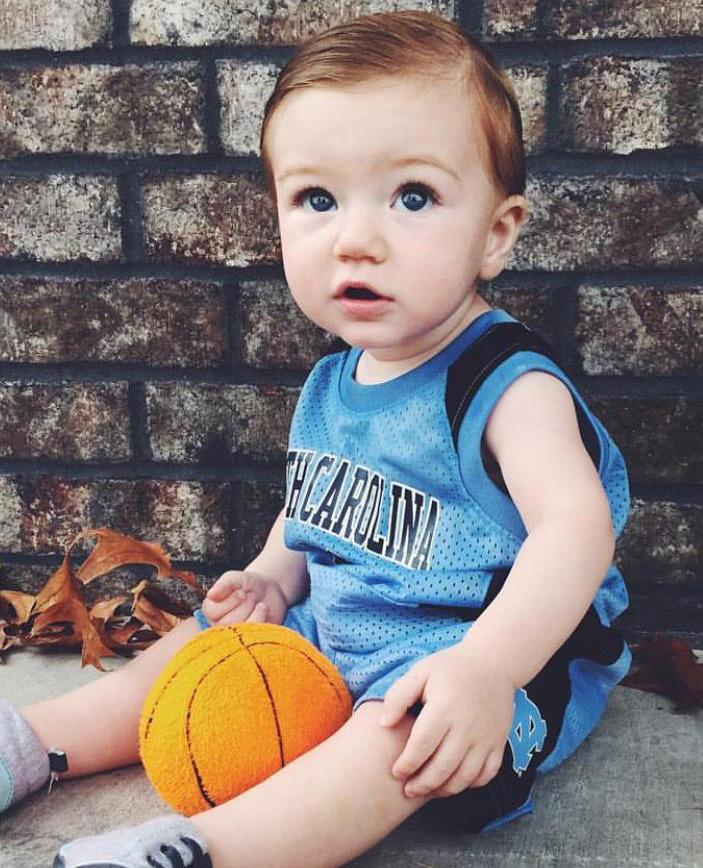
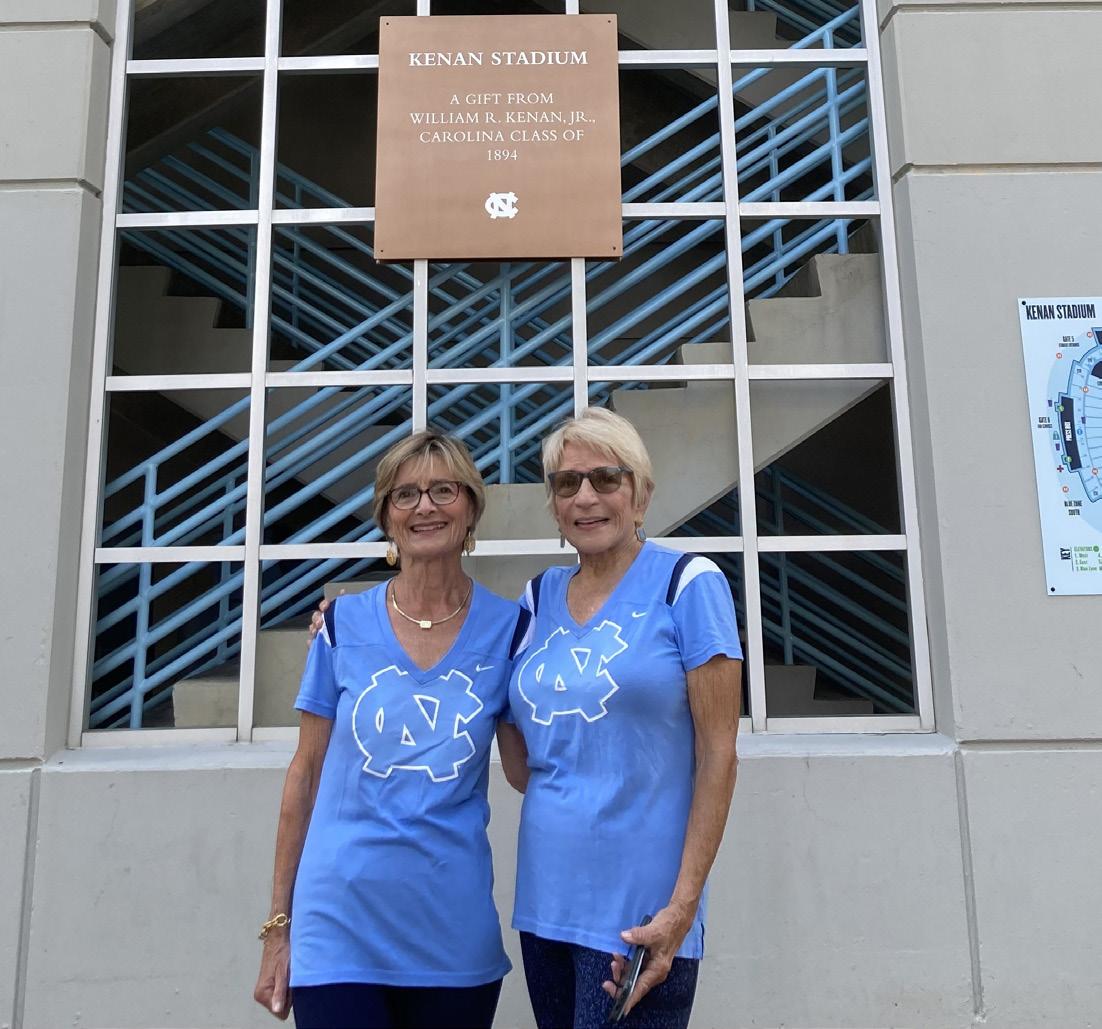
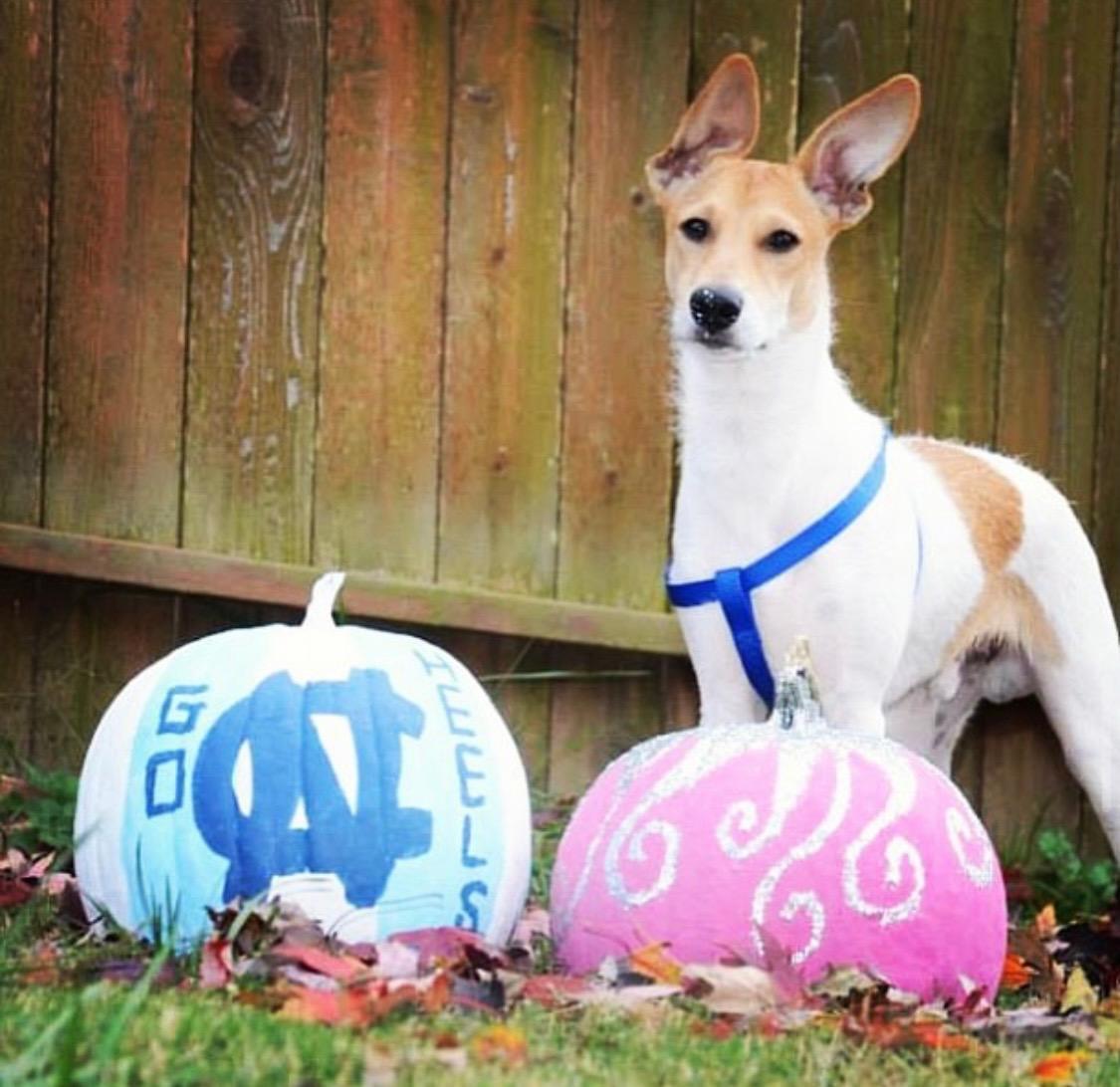


Chris Himebauch & Catherine Kirkpatrick // Chapel Hill, N.C.
Two years ago, we were Dunkin Donuts for Halloween – Chris even wore his old warm up pants from when he was on the swim team!

Polly Alexander // Raleigh, N.C.
I carved this pumpkin with a downloadable template provided by Carolina Annual Giving. It was the centerpiece for an Oct 30, 2021 UNC football game watching party. We lost to Notre Dame but the pumpkin was a win!
Linda Butler & Jean Neville
Although tailgates for Tar Heel football games are a fall must do, we have a decades long tradition of walking campus on Saturdays and making a special stop at Kenan Stadium to salute our Heels and send good vibes for a Tar Heel victory whether we are playing home or away. As Carolina grads and Chapel Hill residents we know it firsthand what it means when it’s a GDTBATH.
Halloween is always a unique and colorful holiday in Chapel Hill, costumes are fun and sometimes outlandish. This Jack-o-lantern is a one of a kind and graces my front porch every year. Go Heels!”

There is no better season than fall in Chapel Hill.
Spring is gorgeous (but the pollen!).
Summer slows down (but the heat!).
Winter has basketball (but the cold!).
Fall, though, has no drawbacks. Fall is that first chilly morning of September and leaves starting to hit the ground and football tailgating.
Because fall has so much to offer, everyone has their own opinion about the perfect way to spend a fall day in Chapel Hill. What follows are a few quintessential fall Chapel Hill experiences.
There’s no debate about the enjoyment of a good football tailgate. Whether your preferred spot is on Stadium Drive, University Baptist on Franklin Street, or a more out-of-the-way spot that you prefer to keep secret from the masses, there’s just something about setting up some food and a selection of beverages and then being able to walk over to Kenan Stadium after the meal.
The disagreement, however, comes during the discussion of the best kickoff time for the best tailgating. It’s universally agreed that noon is the worst. While it does provide some menu variety—Sunrise Biscuit or a breakfast casserole is always a good pick—it also requires a very early start. Depending on your travel distance, it just feels wrong to roll out of the driveway before first light.
So what’s the ideal time? 8 p.m. is too late, and given the realities of a television broadcast, 7 p.m. probably is also. Carolina has enjoyed an occasional 6 p.m. start in recent years, and those are terrific for locals, but still mean a very late arrival home if you’re returning to, say, Charlotte.
Which brings us to possibly the greatest kickoff time of them all—3:30 p.m. Late enough to allow for pregame tailgating, but early enough to also allow for postgame tailgating if you so desire. The game starts in the warmth of the day but ends in some of that sought-after fall shade. This is the perfect kickoff time to either make a full day of it if you choose, or spend the night if you’re in for a longer adventure.
There was a time when it felt like Carolina had no way of avoiding the dreaded noon kickoff. As the wins have accumulated during Mack Brown’s second tenure, the start times have become more favorable. Entering the month of October and dating
The best way to spend a fall afternoon in Chapel Hill is:
GUY HOLBROOK @guy_holbrook
Sutton’s for lunch, a walk through campus, a coldy at TOPO
BRIAN HUNTER @bchunter53
Slow stroll from Franklin St. to Kenan Stadium for a late afternoon kickoff, then back again after, maybe stop at a bench on campus
Caroline Spencer @cclaytonr
Hanging on the Dead Mule patio.
Justin @HeelsandCrypto
Lunch at 4 Corners, sitting on bench on campus watching the fall colors in the trees and then strolling over to Kenan before a 3:30 kickoff
JAKE PARROTT @parrottman2
Tailgating on the top of the Craige Deck with family, great friends (and often new acquaintances), and going to the football game in Kenan.
STEVE COLE @laurinburger
Tar Heel Village and Parker’s BBQ.
CAMERON TERRELL @Cameron_J_T
A blue cup and a football game
VIRGINIA RABY @va_ellen
On a non-football day, my husband and I walk the paths of the NC Botanical Garden, grab bagels at Brandwein’s to take home to Raleigh and eat lunch at Merritt’s or Al’s. A joy to be surrounded by Carolina blue!
DONNIE VERNON @DonnieVernon6
A Blue Cup, always!
JOHNNY @jtunc23
Tailgating on a Saturday afternoon with friends and family before heading into Kenan.
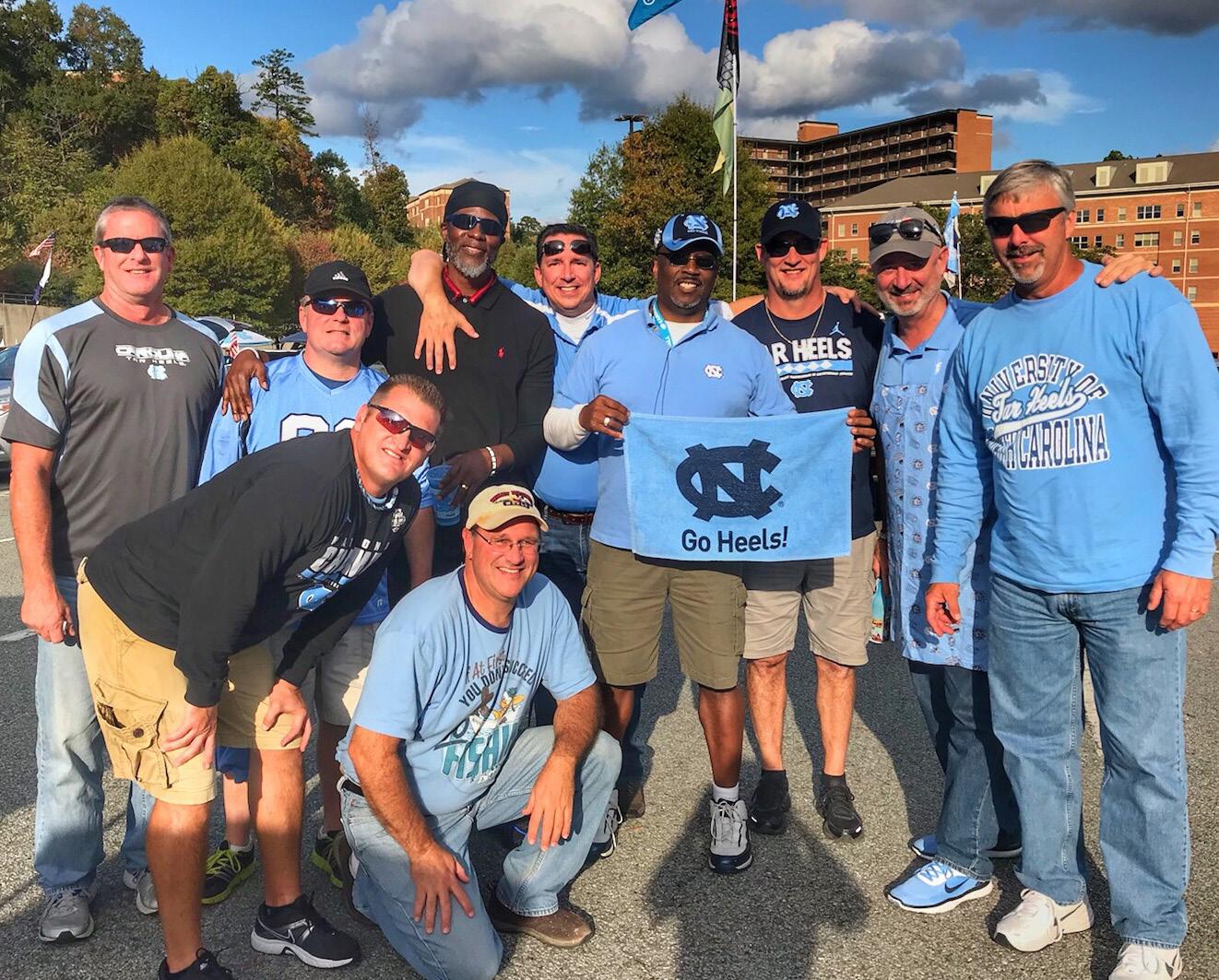
back to the end of the Covid season, seven of Carolina’s last 15 home games and five of the last nine had started at 3:30.
The change in the weather means all those Franklin Street (and beyond) restaurants can finally get more use out of their patio areas. The two establishments named most often in our informal survey were, by far, He’s Not Here and Top of the Hill. Perhaps different types of atmospheres, but the general idea is the same—an opportunity to enjoy unrushed time with friends and family in places that have survived for multiple generations of Tar Heels.
He’s Not has welcomed everyone from famous fans like Usher—who stopped by during a recent tour—to a legion of undergraduates thirsty for a famous Blue Cup. Top of the Hill, the home of the weekly head coach radio shows during the football and basketball seasons, transforms into the hub of Chapel Hill on game days, when both Tar Heels and visiting fans alike seem to find their way to the corner of Franklin and Columbia.
“While Chapel Hill is deservedly famous for its glorious spring, nothing is better than a fall afternoon or evening at Top of the Hill,” says Top O’ owner and Rams Club member Scott Maitland. “Kuralt’s crisp October air, the changing leaves and the distinct energy of a football game day all collectively enjoyed simultaneously by generations of Tar Heel fans makes Top of the Hill a mecca for anyone who bleeds Carolina Blue.”
Even if you haven’t experienced it first-hand, you’ve likely heard about it. Halloween on Franklin Street is a very different kind of holiday. Thanks to careful cultivation by the town, which was concerned it might go the same way as the much-lamented Apple Chill (the last spring festival under that name was in 2006, ending an over 30-year run), it’s not quite
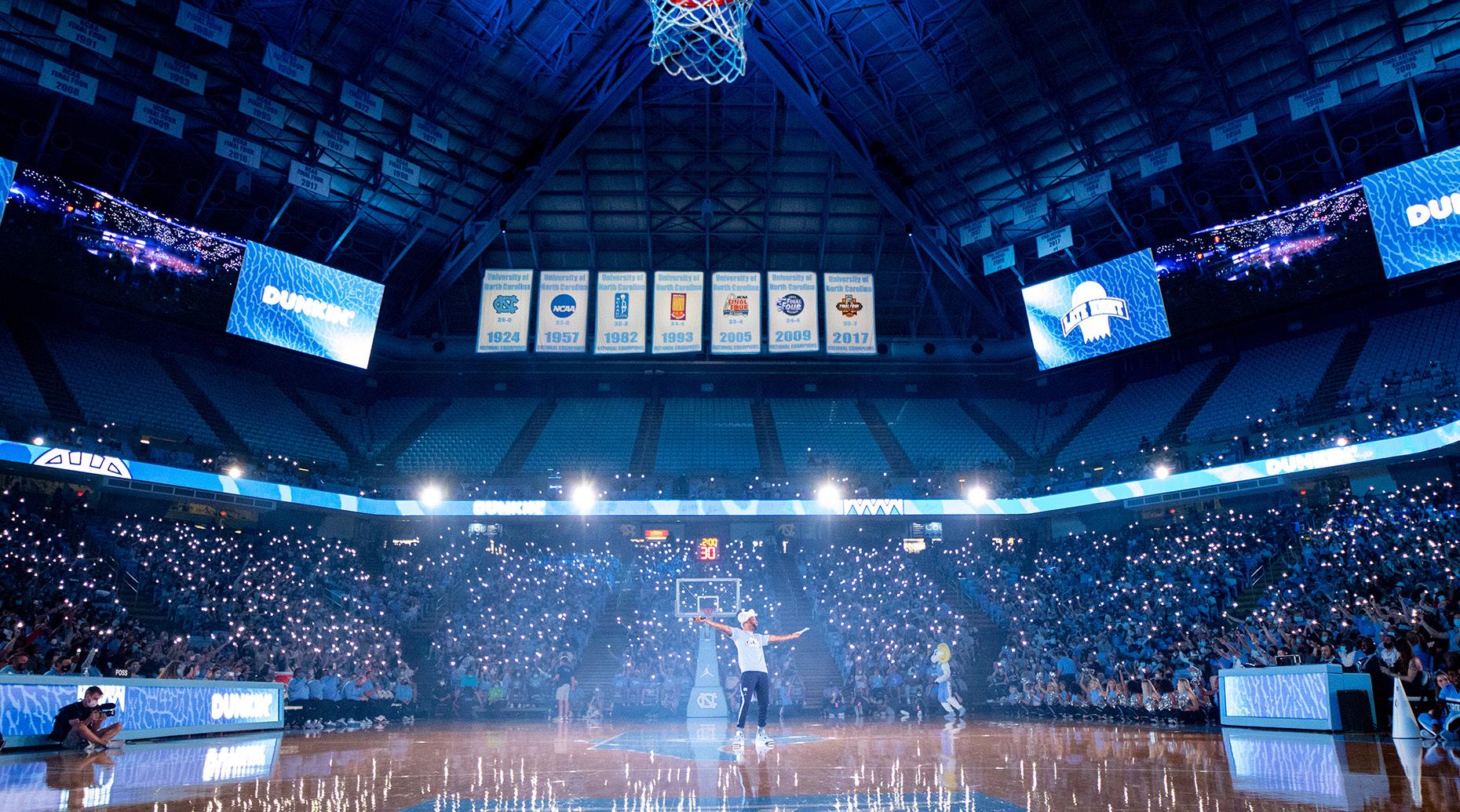
on scale with the mammoth production of the early 2000s.
That’s by design, as the idea has been to limit the festivities more closely to town residents and students. There’s still a significant amount of creative costumes and celebrations, some of which will be appropriate for these pages and some which … might not. And when Halloween falls on a weekend, get ready for an entire three days of celebrations.
There’s no surer way of closely pinpointing your age than to find out if your childhood includes one of those glorious fall Saturdays when you watched the football Tar Heels in Kenan Stadium, then walked down the hill to the Smith Center to catch your first glimpse of the basketball Tar Heels in the annual Blue-White game.
In an era—the prime time for the doubleheader was the mid/late 1980s and the early/mid 1990s—when game options on television weren’t as prevalent as they are now, it was an incredible luxury to be able to watch two Tar Heel teams on the same day in the span of a few hours. Because you hadn’t watched complete highlight tapes on the internet, it was often the first opportunity to see players like JR Reid or Eric Montross in person.
And, of course, during the basketball warmups, you had to spend time breaking down the football game you’d just watched. I vividly remember evaluating Carolina’s chances at the 1990 All-American Bowl with a
friendly usher while the eventual Final Four participant Tar Heels went through layup lines.
As a parent, I look back now and think: Wow, that was a long day. But as a kid who lived it, it was the best kind of day.
The modern version of that doubleheader is the weekend each fall when Live Action (formerly Late Night until everyone realized that it doesn’t actually take place late at night anymore) and a home football game fall on the same weekend. This year, it was Live Action—featuring the men’s and women’s basketball Tar Heels—on Friday before the Oct. 14 home date with Miami. That’s an opportunity to spend not just a fall day in Chapel Hill, but an entire fall weekend. If the schedule permits, perhaps there’s even time for a women’s soccer game at Dorrance Field or even a game or two of the Fall World Series at Boshamer Stadium.
In other words, it’s the chance to spend a full weekend awash in Tar Heel sports, the fall equivalent of—and this is another issue topic entirely— the old Super Saturday in the spring.
As the need to ensure basketball exhibitions are serving an NIL purpose increases, it’s possible that this relatively recent tradition will undergo some changes in future years. For now, though, it’s a great way to remember that fall is the very best time to be in Chapel Hill.
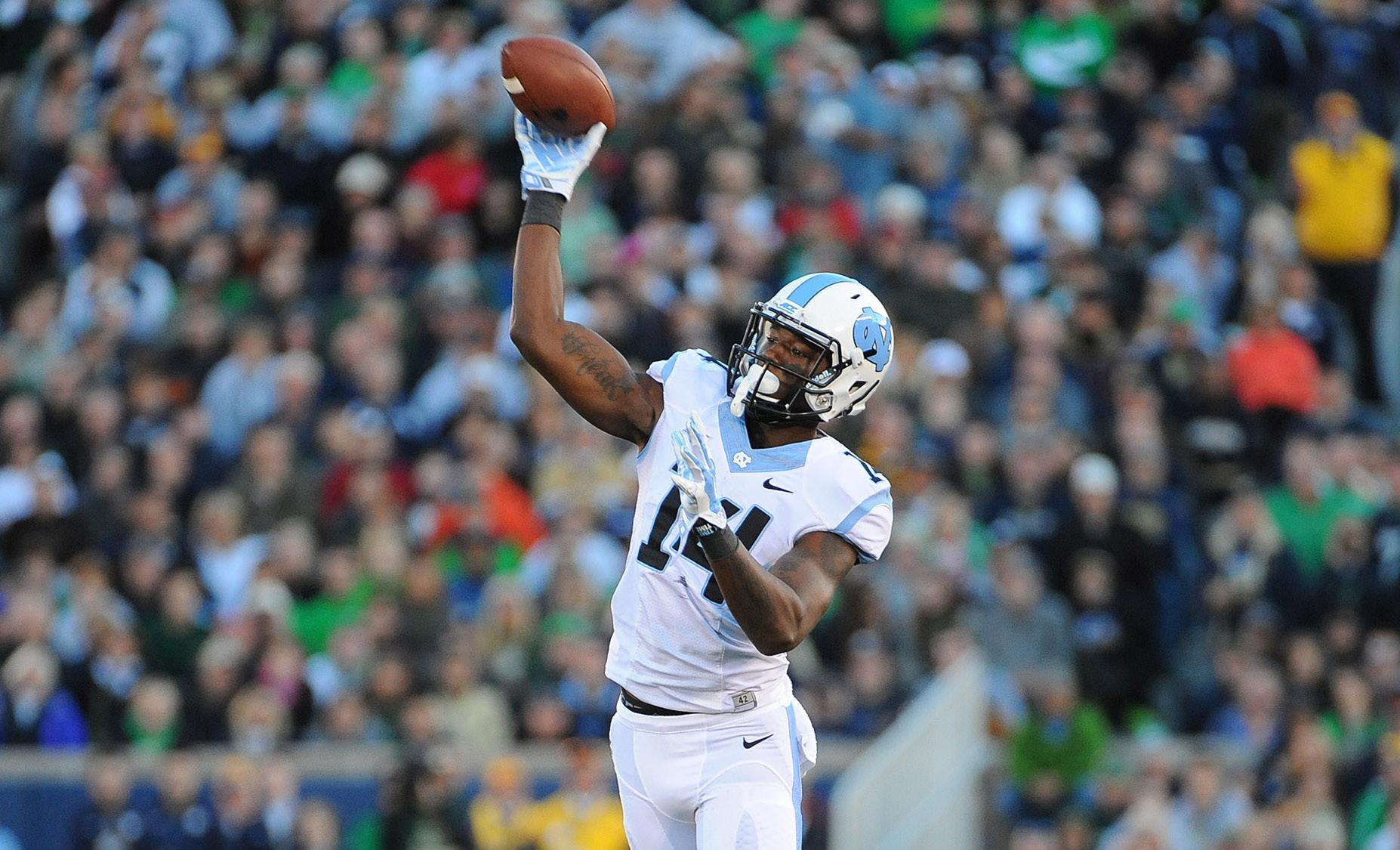
It has to go down as one of the craziest stat lines in the history of college football:
Quinshad Davis, Carolina’s No. 2 all-time leader in career receptions, with a 4-for-4 pass completion percentage and four touchdowns over his Carolina football career from 2012-15.
“That play right now for us is 100 percent,” Tar Heel coach Larry Fedora said after the Tar Heels beat Georgia Tech 38-31 in Atlanta in October 2015, a key play being Davis’s 37-yard touchdown throw to quarterback Marquise Williams after Davis was appearing to run a reverse. “We’ve used it multiple times through the past three years. Quinshad has an accurate arm and a knack for making that play work.”
“Every time we call that play,” Davis said, “I’m thinking touchdown. I’m not sure I want to throw any more. I’m 4-for-4— that might be the best passing rate in all of college football.”
Gimmicks and gadgets have been a part of football as long as fingers have sketched plays in the dirt and human minds have spawned practical jokes. The Carlisle Indians ran the “Statue of Liberty play” nearly a century ago, with one back pretending to pass and another player coming behind him and taking the ball off his hand, and “Old 83” was a version of that play favored by
“THAT PLAY RIGHT NOW FOR US IS 100 PERCENT,” FEDORA SAID AFTER THE TAR HEELS BEAT GEORGIA TECH 38-31 IN ATLANTA IN OCTOBER 2015, A KEY PLAY BEING DAVIS’S 37YARD TOUCHDOWN THROW TO QUARTERBACK MARQUISE WILLIAMS AFTER DAVIS WAS APPEARING TO RUN A REVERSE. “WE’VE USED IT MULTIPLE TIMES THROUGH THE PAST THREE YEARS. QUINSHAD HAS AN ACCURATE ARM AND A KNACK FOR MAKING THAT PLAY WORK.”
coach Fielding Yost at the University of Michigan during the same era. Generations later, Johnny Unitas ran it with the Baltimore Colts and in more recent times, Boise State won the 2007 Fiesta Bowl with an impeccable rendition of the play.
“When a play like that is called, you try not to smile and get excited,” said John Heck, a Tar Heel tackle from 2013-16. “You know the play can score, and you actually get a little nervous bearing down and making sure you’re not the one to screw it up.”
“There’s nothing like the element of surprise,” said Paul Miller, a Tar Heel quarterback of the early 1970s.
Miller should know, as he was the architect of one of the best slight-of-hand plays in Tar Heel history. Carolina had been victimized by Duke in 1969 by “The Shoestring Play,” in which QB Leo Hart kneeled near the sideline to ostensibly tie a loose shoestring, when in fact the rest of the Blue Devil offense was quick-snapping the ball against an unaware Tar Heel defense and scoring a touchdown in a 17-13 win in Durham.
In Kenan Stadium the following year, the Tar Heels had been stoned inside the five yard-line on three successive plays in the second quarter when coach Bill Dooley rolled the dice on fourth down with a hand-off on a power play to the right side for All-America tailback Don McCauley. Miller sensed that Duke linebacker Dick Biddle was keying on McCauley and decided on his own to fake the hand-off to McCauley and run a bootleg around the right side.
“Coach Dooley didn’t know what I was doing,” Miller said. “Don didn’t know. No one knew. If that play didn’t work, I could have just kept running out the back gate and never come back to Chapel Hill.”
Fortunately, 11 Duke players bit on the fake to McCauley, and
Five plays from the trickeration handbook that live forever in Tar Heel annals:
1
Paul Miller bootleg vs. Duke, 1970—Miller plays off Don McCauley’s inside-the-tackles running prowess to fake a hand-off and bootleg it around the right side for a touchdown in Carolina’s 5924 thrashing of the Blue Devils.
Willie Parker “Rooski” vs. Pitt, 2000—It was the last college football game ever in Three Rivers Stadium, and Parker made it memorable by taking a between the legs handoff from Ronald Curry, counting to two and slipping out the back side for an eight-yard score as the Heels prevailed, 20-17.
Quinshad Davis throwback vs. Georgia Tech, 2015—The Tar Heels’ run to the ACC Coastal title was keyed by momentum from their early October win in Atlanta. T.J. Logan pitched the ball to Davis on an apparent reverse, then Davis pulled up and nailed QB Marquise Williams downfield for a 37-yard TD.
Ryan Switzer flea-flicker vs. Duke, 2015— Larry Fedora-coached teams were big on gadget plays and followed later the same year with a sweet trick that launched a 66-31 landslide win over Duke. Williams handed off to Elijah Hood, Duke bit on the run, Hood flipped the ball back to Williams, who nailed Switzer on an 89-yard touchdown.
Chazz Surratt interception vs. Duke, 2019—The Blue Devils tried some misdirection of their own from the two yard-line with time running down—a handoff with the runner stopping at the line of scrimmage, jumping and launching a pass to a receiver who would have snuck behind the mass of defenders. But Surratt, clued in by coordinator Jay Bateman, played it perfectly and intercepted the pass, saving a 20-17 Tar Heel win.
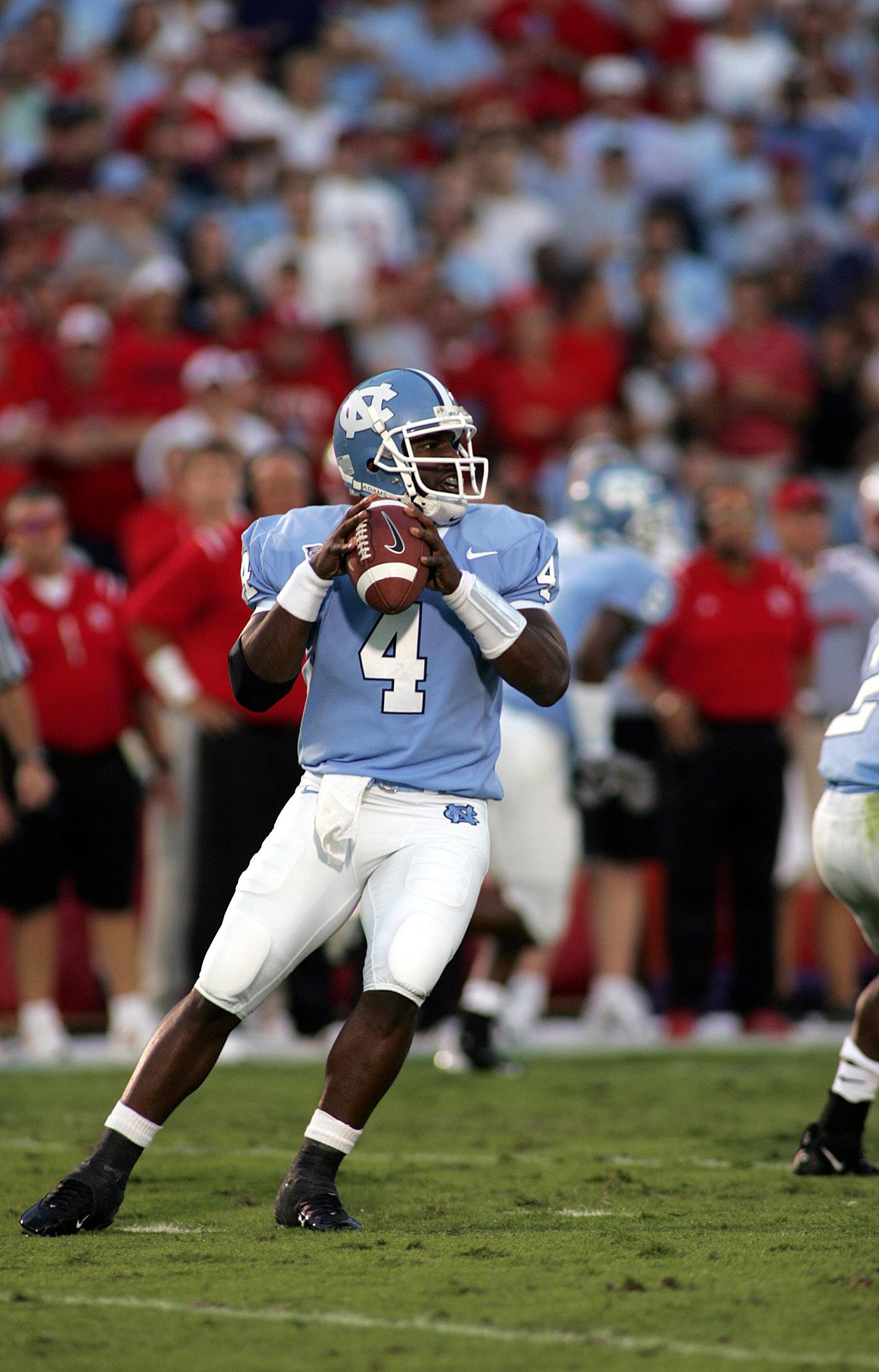
QB DARIAN DURANT FEIGNED A SCREEN PASS TO JAWORSKI POLLOCK IN THE LEFT FLAT, WITH RECEIVERS JESSE HOLLEY AND DERRELE MITCHELL BLOCKING A FEW YARDS DOWNFIELD. WHEN DURANT PUMP FAKED, STATE’S LINEBACKERS AND SECONDARY JUMPED ALL OVER IT. HOLLEY TOOK OFF DOWNFIELD AND NO ONE WAS WITHIN 15 YARDS OF HIM AS HE REELED IN A 23-YARD SCORING PASS.
Miller had an easy jaunt around the right edge to a touchdown as the Tar Heels built up a lead on the way to a 59-34 rout.
“If you look at photographs of that play, you can see my head popping up, looking for the ball,” McCauley said. “I thought I’d fumbled. I had no idea where the ball was.”
One of the most memorable tricks in recent Carolina memory was the “Rooski” used to spring Willie Parker for a touchdown at Pittsburgh in 2000. The Tar Heels drove inside the Pitt 10 late in the first quarter, and Parker lined up just behind the guard and tackle on the right. QB Ronald Curry took the snap and handed the ball off to Parker between his legs, then continued running right as if we were carrying the ball. Nine teammates flowed to the right as well, blocking for Curry. Parker stood still for two counts, then slipped out the back side for an eight-yard score in the Tar Heels’ 20-17 win.
The Tar Heels ran a played called “Sucker” in their 30-24 win over N.C. State in 2004 late in the first half for a touchdown. Coordinator Gary Tranquill installed the play to take advantage of the Wolfpack’s speed and aggressive pursuit. QB Darian Durant feigned a screen pass to Jaworski Pollock in the left flat, with receivers Jesse Holley and Derrele Mitchell blocking a few yards downfield. When Durant pump faked, State’s linebackers and secondary jumped all over it. Holley took off downfield and no one was within 15 yards of him as he reeled in a 23-yard scoring pass.
“It was like throwing chum to the sharks,” receivers coach Gunter Brewer said.
Bobby Rome was a stellar quarterback in high school who eventually moved to fullback at Carolina, but offensive coordinator John Shoop noticed his powerful arm during a Friday walkthrough midway in the 2007 season. Shoop then installed a play that Carolina ran against N.C. State where Rome took a pitch from quarterback T.J. Yates, feigned a run and then reached back and heaved the ball to Brandon Tate, who was 20 yards clear of the nearest State defender and scored easily.
“I knew he would be open,” Rome said. “I had no doubt about that. I just didn’t want to over-throw him or under-throw him. I wanted to hit him in stride.”
The Tar Heels during Coach Mack Brown’s first tenure at Carolina from 1988-97 made good use of playing off Natrone Means’ prolific rushing talents to set up misdirection plays. One of the best came, appropriately enough, on Halloween in 1992 when playing at Maryland. Means had rushed for 234 yards through three quarters and got the ball on a toss sweep from the 12 yard-line. The entire Terrapin defense swarmed him on the right sideline but Means had flipped the ball to flanker Randall Felton coming around the opposite direction. It was a walk-in touchdown for Felton and provided the winning score in a 31-24 game.
“We were going sweep, sweep, sweep, so coming back with Randall was a great call,” QB Jason Stanicek said. “They weren’t
expecting it, obviously.”
Special teams are fertile grounds for gimmicks, and kicker Brian Schmitz was 3-for-3 during his Carolina career from 199699 passing the ball on fake punts. One of them came in the Gator Bowl following the 1997 season against Virginia Tech, when Schmitz passed 28 yards to Brian Simmons as the Heels cruised to a 42-3 win.
“All we heard about all week was how great their special teams were, how many punts they had blocked,” Schmitz said. “We thought we could take advantage of their aggressiveness by throwing the ball over them.”
And of course, the ultimate victory in the trick play domain is foiling one from the opposition.
Jay Bateman was the Tar Heels’ defensive coordinator in 2019 during Brown’s first year of his second stint at Carolina. In the final stages of the Duke game in Kenan Stadium in late October and the Blue Devils at the Carolina two yard-line, Bateman sensed Duke would feign a run into the interior, then have the ball-carrier jump just before the line of scrimmage and launch a “pop pass” to a receiver who’d snuck behind the crashing defense. During a time out before the fateful snap, he clued his players into his thinking.
“When I saw the formation, I was pretty confident that is what we were getting,” Bateman said.
Properly warned, Tar Heel linebacker Chazz Surratt jumped on that very play, intercepted the ball and preserved a 20-17 win.
“I think it’s crazy. Stuff happens for a reason,” Surratt said. “I was in that position for a reason. I’ve got to thank God, first off. Stuff like that just doesn’t happen.”
“The rooski”
THE TAR HEELS DROVE INSIDE THE PITT 10 LATE IN THE FIRST QUARTER, AND PARKER LINED UP JUST BEHIND THE GUARD AND TACKLE ON THE RIGHT. QB RONALD CURRY TOOK THE SNAP AND HANDED THE BALL OFF TO PARKER BETWEEN HIS LEGS, THEN CONTINUED RUNNING RIGHT AS IF WE WERE CARRYING THE BALL. NINE TEAMMATES FLOWED TO THE RIGHT AS WELL, BLOCKING FOR CURRY. PARKER STOOD STILL FOR TWO COUNTS, THEN SLIPPED OUT THE BACK SIDE FOR AN EIGHT-YARD SCORE.

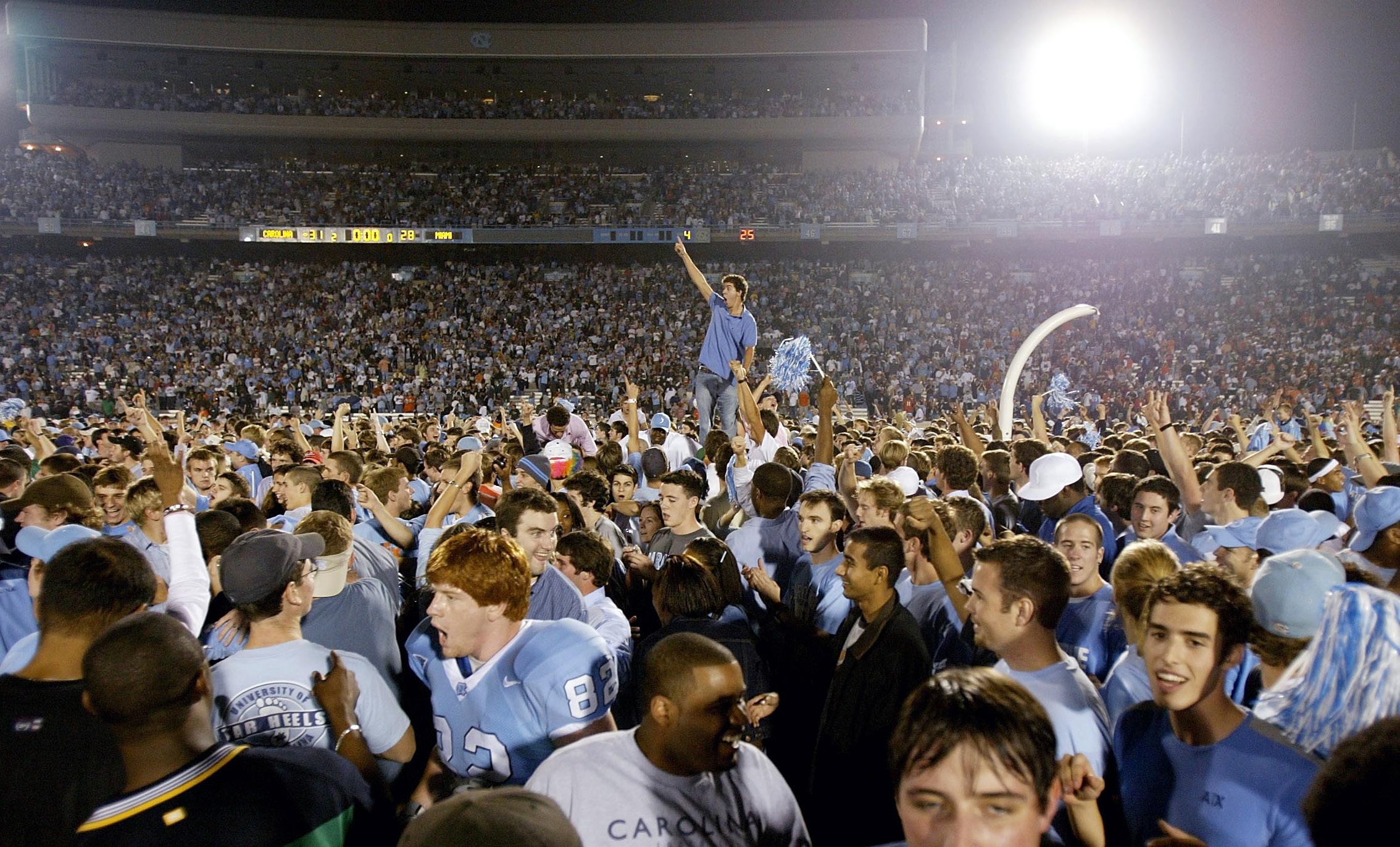
Tar Heel games don’t frequently mix with Halloween, but when they do it’s often a memorable resultBY ADAM LUCAS PHOTOS BY UNC ATHLETIC COMMUNICATIONS
There’s something about a big Halloween home game on a college campus. Especially in Chapel Hill, where Halloween has become a near national holiday on Franklin Street, it’s a ripe environment for memorable Tar Heel events. The air is a little cooler and there’s an overall sense of unpredictability.
At least, that’s how we remembered it. But in checking the Carolina athletics archives, the amount of signature Tar Heel events on Halloween is very few. Part of the explanation is the fact that Kenan Stadium didn’t have permanent lights until 1988, which naturally limited the opportunities for Halloween evening memories.
In perusing the record books, these are a few of the notable Halloween contests.
If you could only have one “Heeloween” representative, this would likely be the choice—and it didn’t even officially take place on Halloween.
But it still had all the ingredients of a memorable night in Chapel Hill. It was a night game against the vaunted Hurricanes, an opponent ranked fourth nationally in that week’s Associated Press poll. Carolina had never beaten a top-five foe until Connor Barth’s game-winning 42yard field goal sailed through the uprights on the final play of the game.
Barth is etched in the memories of most Tar Heel fans. But it was Chad Scott, who was playing on a hip pointer, who put John Bunting’s
team on the doorstep of an epic win, rushing for 175 yards and two touchdowns against a talented Hurricanes defense.
When Barth hit his field goal, the crowd of 51,000 tore down the goalposts and celebrated on Franklin Street. The Saturday night kickoff combined with the growing Halloween weekend festivities in Chapel Hill made for an electric combination. In 2004, Halloween on Franklin was big—a crowd estimated at 80,000 descended on Franklin Street that year—but didn’t yet feel like it had peaked. The crowds eventually got out of hand, leading the town to scale back the festivities later in the decade, but in 2004 you could still take the park and ride to see all the shenanigans, as if it was a big sporting event.
Barth’s game-winner essentially kicked off a full 24 hours of Chapel Hill celebrations, making it the most memorable Heeloween of them all.
Midnight Madness hadn’t yet become big business in college basketball, and NCAA rules still required the event to truly take place at midnight, mandating that the first official practice of the season could begin at 12 a.m. on October 31 of each season.
Several schools held a Midnight Madness event every year, celebrating the fanaticism of the diehards who would turn out at midnight to watch the first practice of the season. But Dean Smith preferred not to hold
such a late event on a school night.
Before the 1992-93 season, however, Oct. 31 fell on a Saturday, meaning the event could be held on a Friday night, Oct. 30. Smith consented to holding a Midnight Madness event at the Smith Center. This set up a full Saturday of Carolina events, beginning with the basketball festivities and—for many students—rolling straight into Halloween celebrations.
In 1992, the first practice of the season didn’t yet include the pyrotechnics and spotlights to which you might be accustomed today. Instead, it began ordinarily enough, with the seniors grabbing the microphone to say a few words for team introductions before the clock hit midnight.
Until, that is, Henrik Rodl stepped to the front. Playing off the Halloween theme and with his slight German accent, the senior guard proclaimed, “This team is going to be scaaaaary.”
Everyone in attendance broke up laughing. Even now, 30 years later, it still makes Rodl’s teammates laugh. “That was all Henrik and his corny German humor,” says Travis Stephenson, who played two seasons for the Heels as a walk-on. “The way he said it was what made it so funny. You just had to hear him say it.”
Rodl was right. The Tar Heels were indeed scary, and went on to win the 1993 national championship by defeating Michigan’s vaunted Fab Five in a memorable title game.
Football
October 31, 1992
Carolina 31, Maryland 28
October 31, 1987
Carolina 27, Maryland 14
October 31, 1981
Carolina 17, Maryland 10
In the days before a computer was spitting out the Atlantic Coast Conference football schedule, a unique quirk hit the Tar Heels. In the span of just over a decade, they played three different Halloween games at ACC foe Maryland, winning all three.
The most famous of those games was probably the last one, as Mack Brown had piloted his Tar Heels into the national top 25 in 1992. Ranked 22nd in the country, Carolina followed a simple gameplan: hand the ball to Natrone Means. He carried 31 times and gained 249 yards, helping provide the one-touchdown victory. That included scoring runs of 27 and 76 yards, plus serving as the decoy on the game-winning score, a reverse pitch to Randall Felton.
The 1981 victory included a win over Terp quarterback Boomer Esiason, who was knocked out of the game in the fourth quarter while trying to lead a game-tying drive. A Carolina 20-yard touchdown pass from Scott Stankavage to Tyrone Anthony proved to be the winning touchdown.
The game also marked the beginning of a successful career change for Ethan Horton, who previously had been a reserve quarterback. The
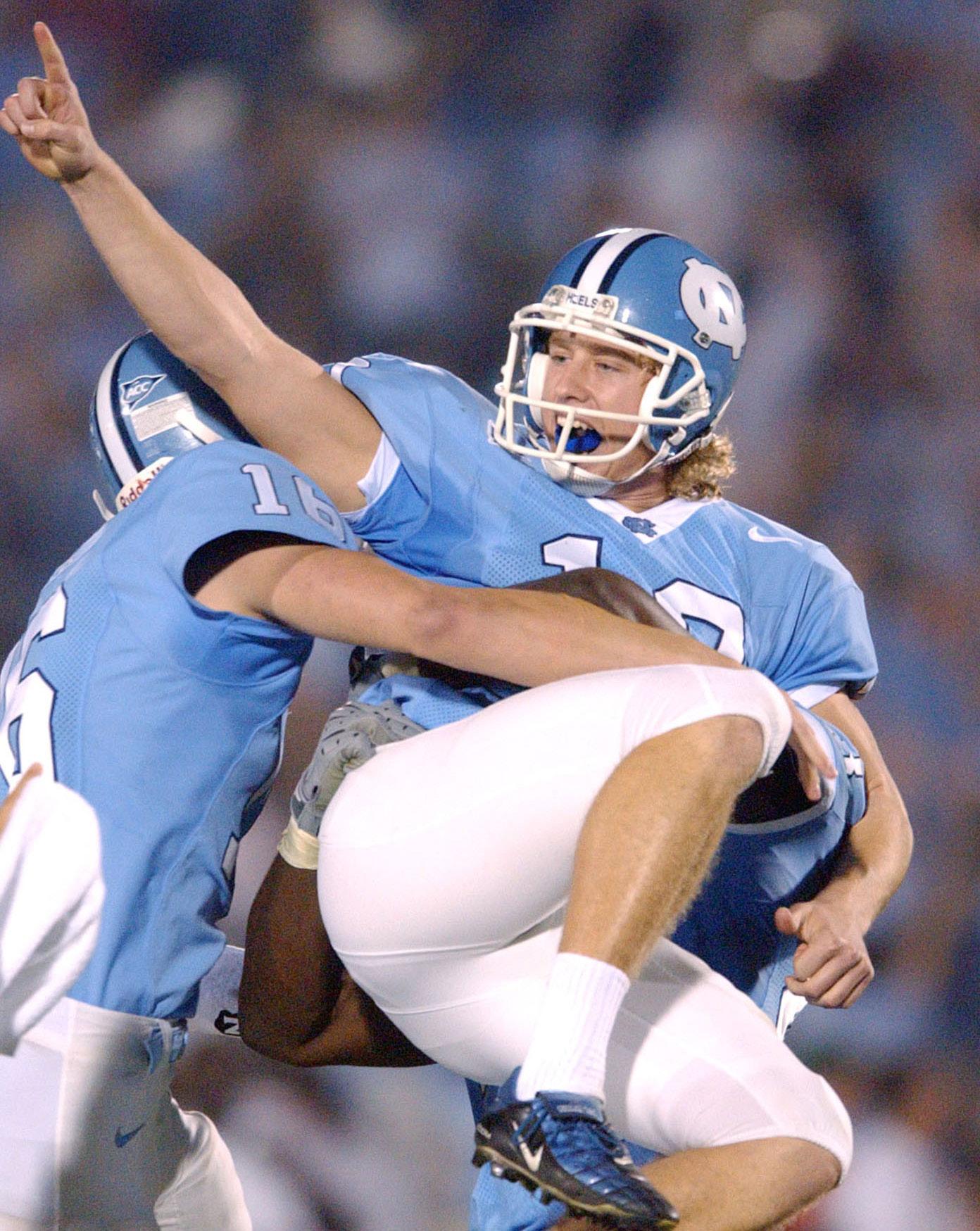
Tar Heels instead started him at tailback, and he rewarded them with a touchdown. Horton went on to become the co-MVP of the Gator Bowl and Sun Bowl at that position, then became the ACC Player of the Year at tailback in 1984. The Kannapolis native went on to play almost a decade in the NFL, eventually switching to tight end.
This qualified as a narrow victory for one of the best teams in Anson Dorrance’s storied history as Carolina’s head coach. His Tar Heels were on the way to an incredible 27-0-0 record in which they outscored opponents by a combined 113-11 margin.
But the Seminoles, a program on the rise, managed to at least keep the night close on the scoreboard, as Mary McDowell’s goal in the 67th minute was the only marker in front of a stellar crowd of nearly 2,000 that was able to go straight from Fetzer Field to Franklin Street.
Carolina controlled the overall play, notching 14 corner kicks to FSU’s one and outshooting the visitors 23-4. But that wasn’t unusual for a team led by Heather O’Reilly and Lindsay Tarpley that became the first unbeaten and untied team in Chapel Hill since Mia Hamm’s 1993 squad— and also the last team in school history to achieve that feat.

A ROGUES’ GALLERY OF THE OPPOSING PLAYERS AND COACHES TAR HEEL FANS HAVE LOVED TO CHEER AGAINSTBY ADAM LUCAS PHOTO BY ALL SPORT
You can’t have Halloween without villains. And although Carolina has had an uncommon level of success across all sports, there are a few individuals and teams who haunt the dreams of every Tar Heel. Turn the lights on, check under the bed, and double-check the doors just to make sure none of these ghouls are hiding nearby this Halloween.
No one was happier to see Wilson inexplicably pack up for Wisconsin (in the era before frequent player movement) than the Tar Heels. The mobile quarterback had tried to get the previous Tar Heel coaching staff interested in him, but the coaches thought he was too small—to be fair, a common evaluation at that point in his career.
He used the slight to terrorize Carolina for three seasons. In 2008, he threw for 279 yards and rushed for 57 more in a 41-10 NC State walloping of the Tar Heels. In 2009, Carolina was ranked in the top 25 and the Pack was under .500, but Wilson threw for four touchdowns in Raleigh. The backbreaker was a 38-yard go-ahead fourth quarter scoring pass that gave Wilson’s team their final winning 28-27 margin.
Just to make sure he lived forever in Tar Heel infamy, Wilson did it again in 2010, this time at Kenan Stadium. He didn’t have a great statistical day (completing just 15-of-29 passing) but he made the plays everyone remembers. On a key fourth down late in the third quarter, with Butch Davis’ team holding a 19-10 lead, Wilson was under pressure and forced to scramble. He flung the ball towards the end zone. It was tipped by Da’Norris Searcy en route, but Owen Spencer snatched it out of the air before it hit the turf. State eventually captured a 29-25 win, moving Wilson to 3-0 all-time against his rival.
It’s hard to think of this group as anything other than a trio, as they represented the Duke program during the time that Mike Krzyzewski’s program was mounting a serious threat to the Tar Heels.
Ferry was the first, and was also the subject of a heated recruiting battle between Krzyzewski and Dean Smith. He ultimately picked Duke, and was part of the Devils’ ballyhooed triple crown season against Carolina in 1988, when the Devils swept all three meetings, including the ACC Tournament championship game. A Carolina win in the 1989 ACC Tournament title game gave the Heels a 5-5 record against Ferry in his decorated career, and at the time, it seemed no one could more embody the Duke ethos than Ferry.
Little did we know what was coming. Laettner was essentially Ferry 2.0; a similar type of player with a rawer edge, significantly more smugness, and greater national attention. That’s also because Laettner was a winner, as he helped lead
Duke to back to back national championships in 1991 and 1992. Just like Ferry, Laettner had considered Carolina during the recruiting process and came on an official visit to Chapel Hill. But he was the perfect fit in many ways for Duke. Carolina had decent success against Laettner, compiling a 6-5 record against him, including memorable wins in the 1991 ACC Tournament championship and the Bloody Montross game in 1992 at the Smith Center that snapped a Blue Devil undefeated streak.
But old grudges die hard. Laettner mistakenly was booked into the Carolina team hotel during the 2022 Final Four in New Orleans. Within a day of wandering around the lobby, Laettner—still a very recognizable face—switched hotels.
And then there was Hurley. He actually inflicted less personal damage on Carolina, as King Rice dominated him when he was a young player, and the chants of “Hur-ley” at the Smith Center seemed to rattle him early in his career. But there was just something about watching him play that was irritating, and he was—yet again—another Duke hero who considered playing for Carolina. The Tar Heels memorably prioritized Georgia Tech star Kenny Anderson over Hurley (a defensible choice, as Anderson was a superstar and also had some ties to Chapel Hill) and then had to hear about the choice when they got neither. Hurley finished 5-5 against Carolina.
It’s a little surprising that three of Duke’s primary program-changing players had a combined losing record against Carolina. That’s a mark of how tight the rivalry was during the Krzyzewski-Smith era.
The Beavers shortstop had the misfortune of being the face of the Oregon State program during a time when their path collided with two of Carolina’s best teams.
ESPN promoted Barney and the “plucky” Beavers—a team that actually had a significant amount of talent—endlessly when the Tar Heels met OSU in the 2006 and 2007 national championship series. That made him an easy target when Carolina lost a heartbreaker in the 2006 series. By the time Oregon State returned to Omaha in 2007, they had developed more of a swagger, including a truly horrendous rap song penned by their now-head coach and then-catcher, Mitch Canham.
But they also remained very talented, and earned their second straight national title at the expense of Mike Fox’s team. The Tar Heels have made five more trips to Omaha, but Oregon State’s 2007 CWS victory remains the Heels’ last appearance in the championship series.
There’s just something about these West Coast teams that pose problems for North Carolina. Beating the Cardinal has been a longtime passion of Anson Dorrance, who takes immense joy in recruiting head-to-head against a program with some inherent advantages and emerging successful. And the super-competitive Dorrance has relished
every win over Stanford, posting an all-time 10-3-3 record against them and outscoring them 31-9. The most painful defeat, though, was a 2019 College Cup final loss that Stanford won, 5-4, in penalty kicks after a scoreless regulation and two overtime periods.
UCLA is a more recent addition, but they earned their spot. Carolina has dominated the all-time series, with an 11-3-2 mark. But the most recent meeting was a crushing one, as the Tar Heels held the lead late in last season’s College Cup final. But the Bruins made a highly debated decision to play physically in the game’s final minutes of regulation, knocking Carolina goalkeeper Emmie Allen out of the way on the game-tying goal with 17 seconds remaining. UCLA eventually prevailed, winning 3-2 in overtime to deny Dorrance his 22nd NCAA championship.
For whatever reason—career longevity, a singular meeting, an inability to hit the lofty standards of smugness set by the others—these Tar Heel rivals wouldn’t take headline status, but would still raise the blood pressure of any Carolina fan.
BasketbalL
Grayson Allen, Duke
Kris Jenkins, Villanova
Tom McMillen, Maryland
John Roche, South Carolina
Allen’s borderline style of play and Duke’s inability or unwillingness to curb it made him an easy target. Jenkins, well, you know what happened in 2016. McMillen was the subject of a tense recruiting battle between the Terps and Tar Heels before being swayed by his mother and going to College Park. Dean Smith had to remind the Carmichael crowd to treat him as a guest and not as an interloper. Roche is a throwback to the peak of the Carolina-South Carolina hardwood rivalry, and his physical style of play likely keeps him near the top of the villains list for Tar Heels of his generation.
Football:
Steve Spurrier, Duke
Chuck Amato, NC State
Antwan Harris, Virginia
Spurrier is on this list for one reason only: his decision to take a team picture under the Kenan Stadium scoreboard after a 41-0 Duke win against a 1-10 Carolina team in 1989. Amato was almost a cartoon character. He loved tweaking the Tar Heels, but John Bunting also had a 4-2 career record against Amato. Harris’ primary offense was making a game-changing play against one of Mack Brown’s best teams, the 1996 Tar Heels. Harris, a Raleigh native, took an interception return 95 yards for a touchdown to ignite Virginia’s comeback from a late 17-3 deficit in Charlottesville. The heartbreaking loss denied Carolina a major bowl bid.
Gil Hanse thought of every angle. Now it’s your turn. Play Pinehurst No. 4.

It’s time to test your mettle on this rugged masterpiece. Renowned course architect Gil Hanse transformed what Donald Ross first carved out of the sand a century ago into 18 dramatic holes you’ll want to play again and again.
Village of Pinehurst, North Carolina | 888.206.8912 | Visit pinehurst.com



November is Member Appreciation Month, and The Rams Club is excited to celebrate you and your generosity all month long. Because of you, more than 800 Tar Heels every year get to compete at the best school in the country while earning a world-class education.
Beginning November 1, follow along on social media (@theramsclub) and check your weekly Member Update emails for daily giveaways and other surprises!



Four Tar Heel teams -- men’s and women’s lacrosse, softball and baseball--are part of a unique fundraiser for UNC Children’s Hospital. This year marks the third straight Heel-O-Ween Lax Ball event, which started in 2021. The 2023 edition takes place on Oct. 29 and is open to the public, including trick-or-treating stations around Anderson Softball Stadium in addition to the five-inning Lax Ball game. Last year’s event raised over $2,700; for more information or to support these Tar Heel teams with a donation, visit goheels.com/laxball



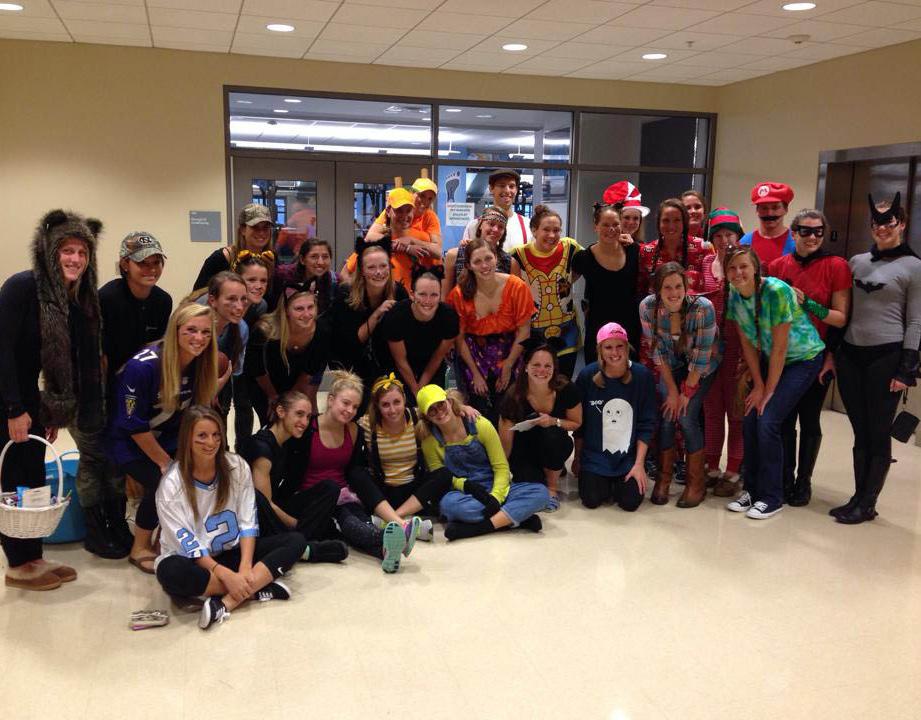




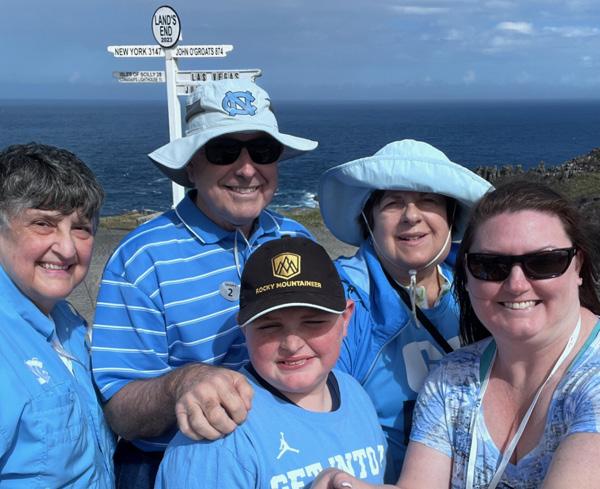



N A I E A R

Rams Club members like to wear their Carolina Blue, and they’ll wear it all over the US and the world. If you have a photo of you in your Carolina gear in front of notable landmarks in the US and abroad, send them our way to be a part of Carolina EveryWear!




To have your photo included:
-Send your photo digitally to bornandbred@ramsclub.com.
-Identify everyone in your photo and the location of the photo.
Here are the “Rules”:
-At least one person in the photo has to be a Rams Club member -You must be wearing Carolina gear
-You must be in front of a notable landmark (sorry, as cool as Kenan Stadium and the Smith Center are, they don’t qualify).
SHOW US YOUR COLORS!

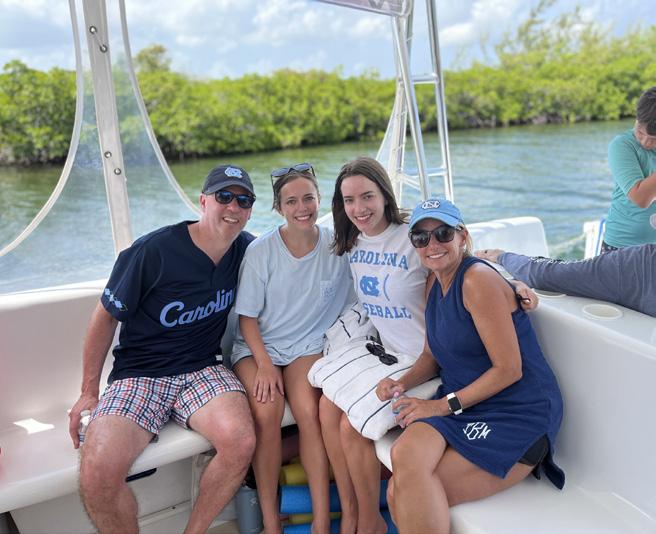
Moraine
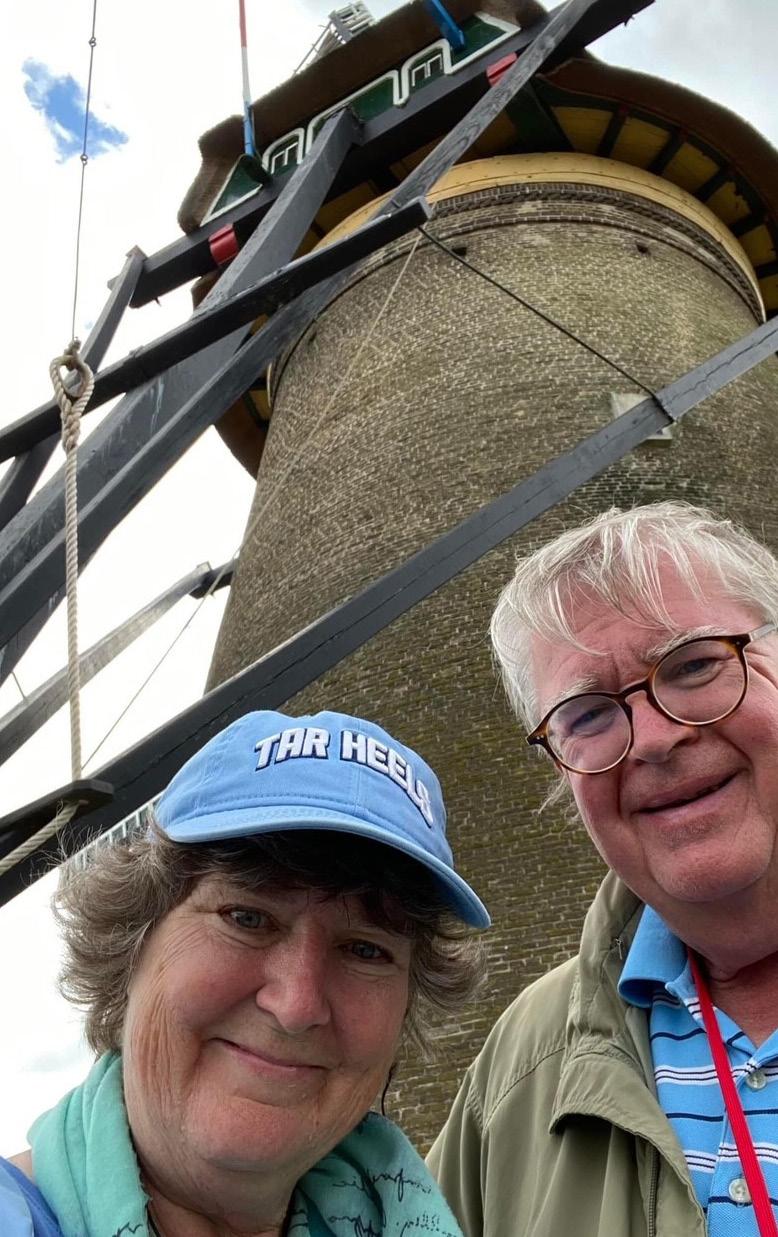
Ellen &
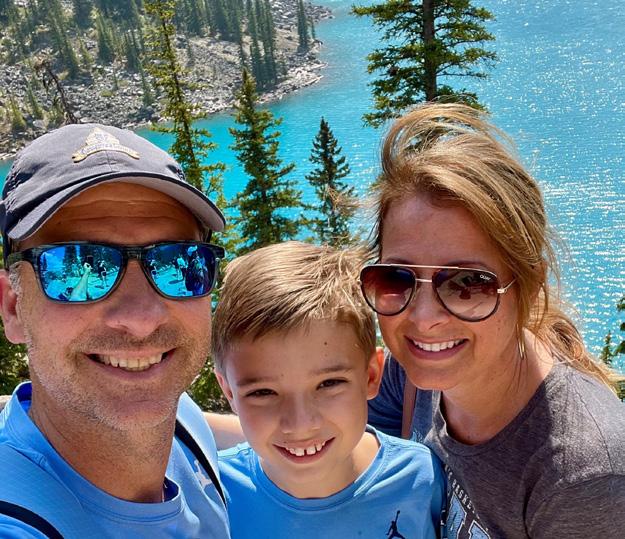







& Jeff Eidson of Elkin, NC, at Waikiki Beach in Honolulu, HI; 27) Roger Davis of Wilmington, NC, at the Swilcan Bridge at St. Andrews in Scotland; 28) Jessica & Robert Guerrero of Simpsonville, SC, on Victoria Street in Edinburgh, Scotland; 29) Buddy McSwain of Winston-Salem in Seydisfjordur, Iceland; 30) Don & Kristy Oates of Chapel Hill at the Matterhorn in Switzerland; 31) Alyana Grace Casiao Escueta & Aljhun Escueta of Richlands, NC, in Chinatown in Singapore; 32) Brett Heavner of Denver, NC, in Munich, Germany; 33) Sally Sander of Chapel Hill at the Athabasca Glacier, Columbia Icefields Parkway in Alberta, Canada; 34) Jan & Ernie Sheldon of Advance, NC, at Copenhagen Denmark;





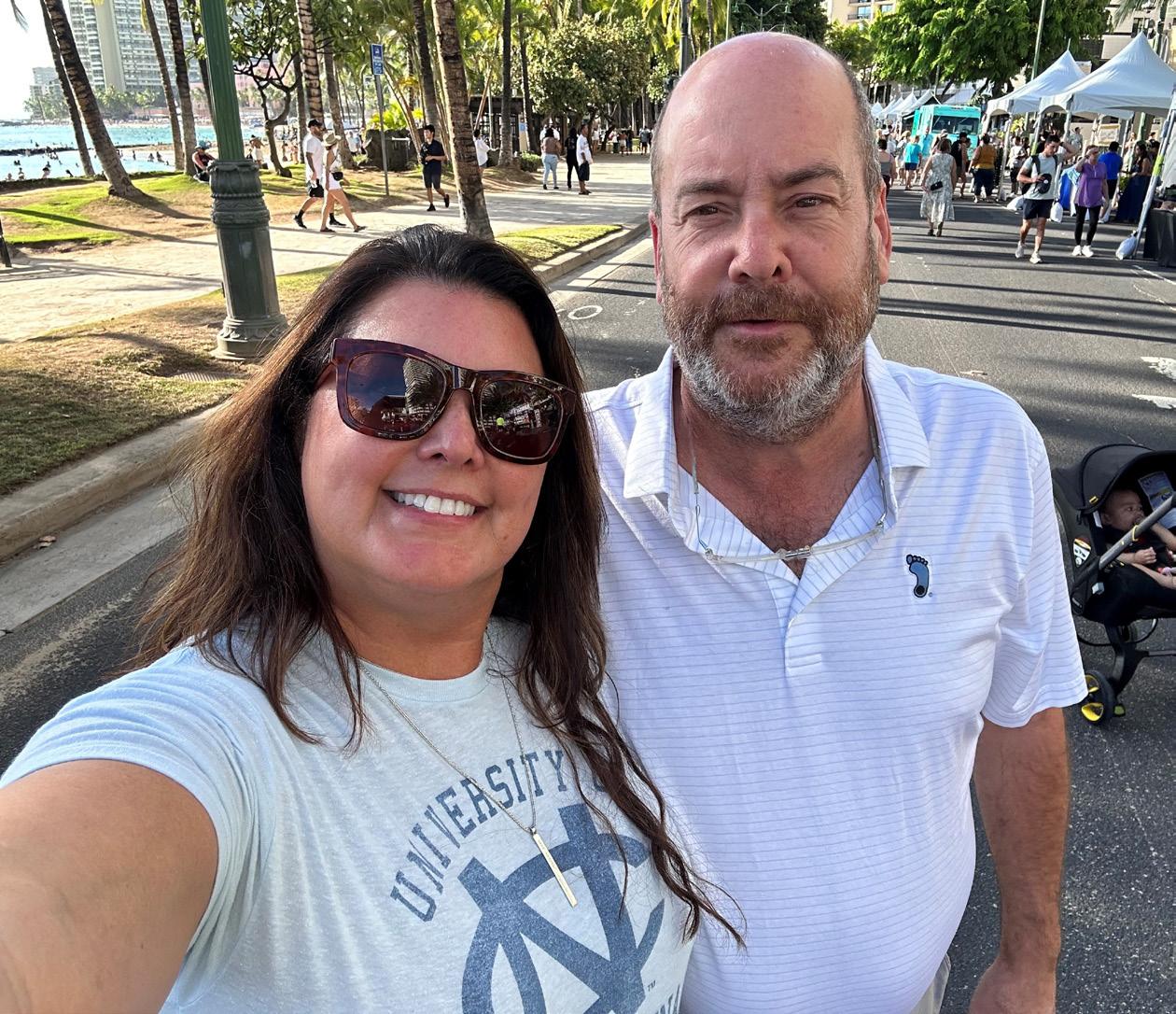

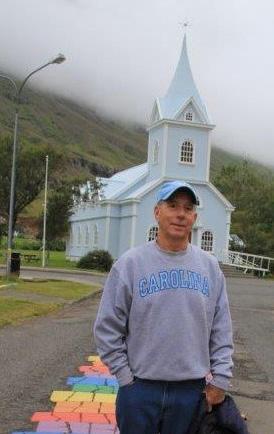


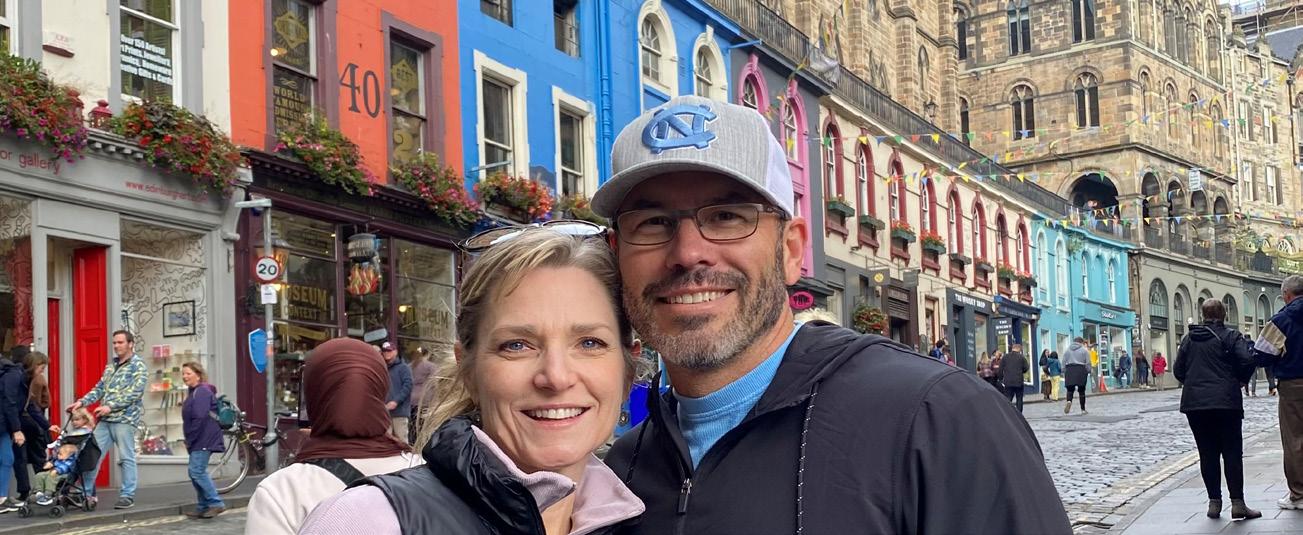

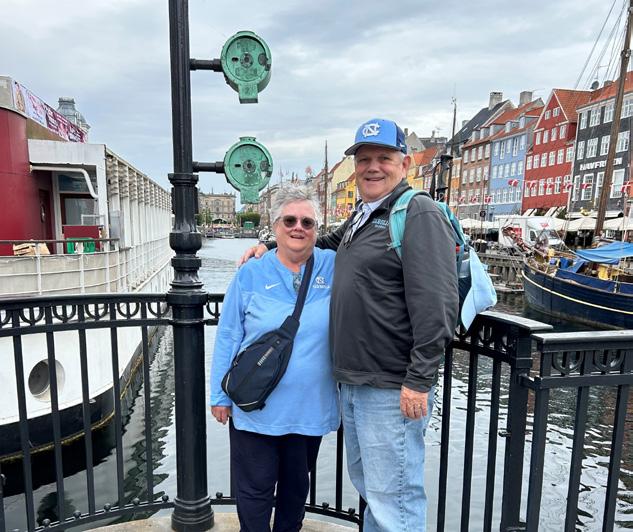
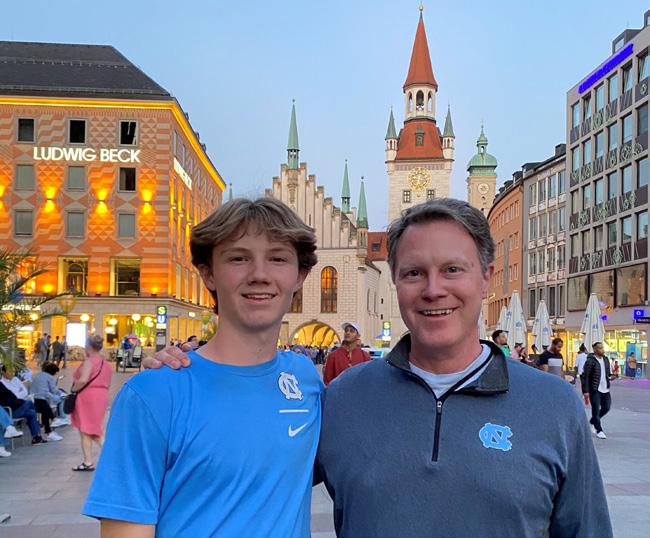


We’ve all seen it … until we haven’t.
There’s very little a basketball crowd enjoys more than a guard who is adept at foiling his defender with some sleight of hand. With that in mind, here’s a look at some of the Tar Heel guards from the last 50 years—with apologies to Tom Kearns and others of his generation, we just didn’t have enough video source material—most likely to dress up as a magician this Halloween.
There are those who will tell you Ford is not only the best Carolina point guard of all time, but the best Carolina player of all time. He remains third all-time in career assists, many of which were piled up by frustrating opposing defenses when orchestrating Dean Smith’s fabled Four Corners.
As Smith would have been quick to tell you, it wasn’t a stall. But it did rely heavily on Ford’s artistry and decision making.
Perhaps the Tar Heel point guard with the most New York City swagger to his game, Smith just played with a verve that reminded you he’d been brought up in Queens and made his reputation at some of the best hoops playground courts in one of the world’s best basketball cities.
The quintessential Smith imagery is him frustrating a defender with a between the legs dribble. What separated him from some other point guards of his generation was that he could use his dribble aggressively to score, not just to create opportunities for his teammates. His speed was also a weapon—they called him “The Jet” for a reason—and he could use that quickness both to score and to lead the fast break for another Tar Heel. His 768 career assists rank second all-time at Carolina.
If you only had the opportunity to watch one Tar Heel play point guard, it might be Ed Cota. It’s true that he arrived in Chapel Hill at the perfect time, as he spent two seasons throwing passes to Vince Carter and Antawn Jamison on a pair of Final Four clubs. But he also played two seasons without that duo, and he helped direct the 2000 team to the third Final Four of his career. He has three of the top five and four of the top eight single-season assist marks in UNC history.
Cota, a Brooklyn native, was another Tar Heel point guard with some big-city flair to his game, both with the dribble and with the pass. He was willing to try almost anything with the ball and often did. His 1,030 career assists might be one of the tougher marks to break in the school record book; no one has even come close since he departed in 2000 (the closest is Raymond Felton’s 697 assists over three seasons).
We’re getting to the point that Felton might be reaching underrated
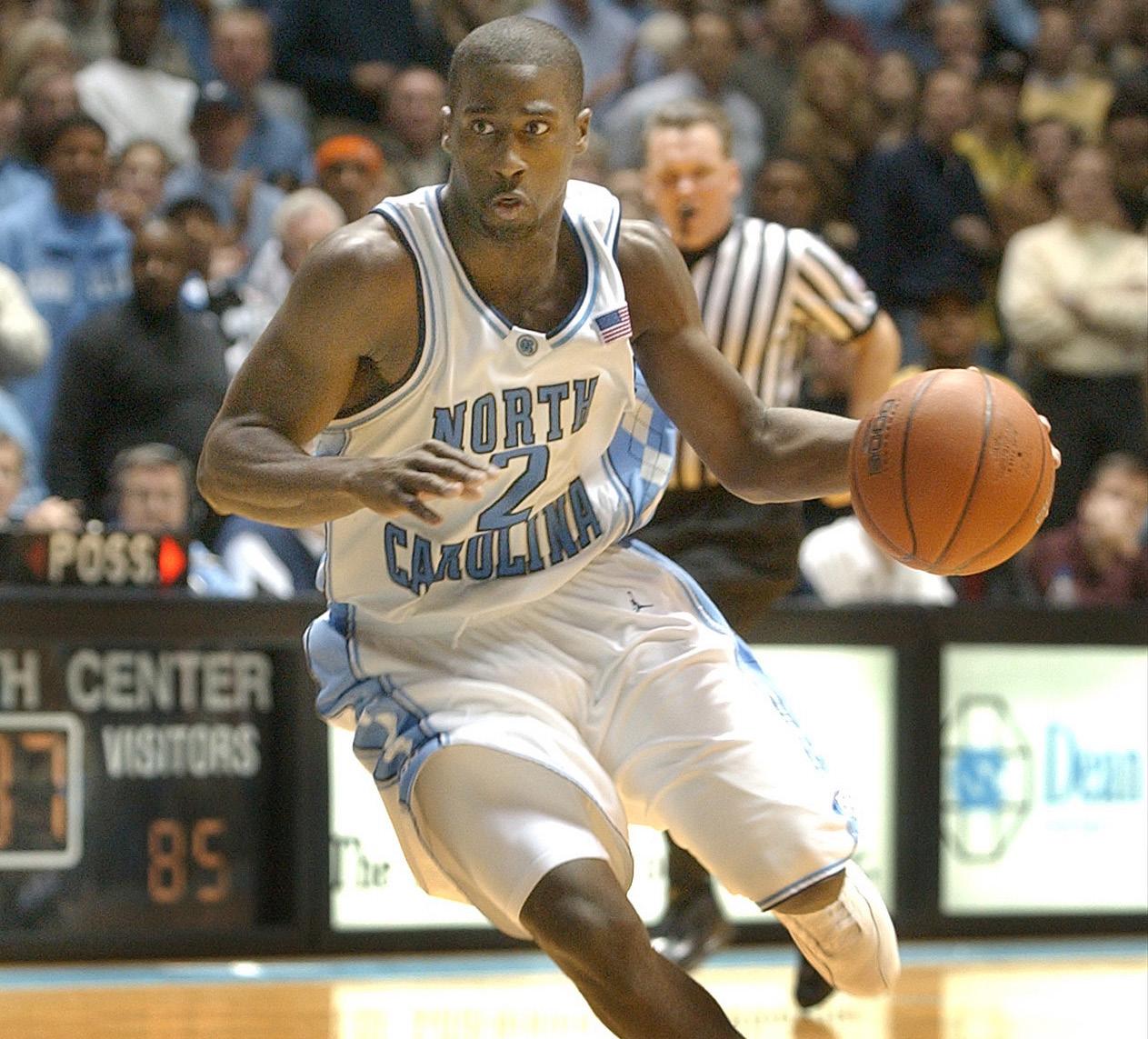
status among younger fans who don’t recall that in addition to his legendary toughness, Felton was also a very skilled playmaker. Need proof? No Tar Heel has ever recorded more than the 18 assists Felton handed out against George Mason during his sophomore campaign. When Roy Williams arrived before the 2003-04 season, he found in Felton a perfect match for his preferred up-tempo style, wrapped in a package that included a leader hungry to learn more about the position.
They thrived together, and Felton’s 249 assists during the 2005 national championship season remains the fourth-most ever in a Carolina season. He is fourth on the all-time career list with 697 assists, ahead of such notable guards as Derrick Phelps (637), Ty Lawson (608) and Marcus Paige (602).
In terms of the best pure passer on this list, Marshall might take the award. It wasn’t necessarily because he had the tightest handle, but because he had the best ability to see what was about to happen instead of what was currently happening. He was equally comfortable throwing a hit-ahead pass to Tyler Zeller on the fast break as he was feeding a teammate in traffic under the hoop. Of the top eight singlegame assist marks in Carolina history, Marshall has five of them
His 351 assists during the 2011-12 season is the NCAA single-season record and is a whopping 67 more than the next-closest Tar Heel (Ed Cota, during the 1999-2000 season). To put it into a different kind of perspective, the top five assist men on the 2022-23 team—RJ Davis, Caleb Love, Pete Nance, Leaky Black and Armando Bacot—had 345 assists combined, or six less than Marshall had as an individual during his record-setting season.
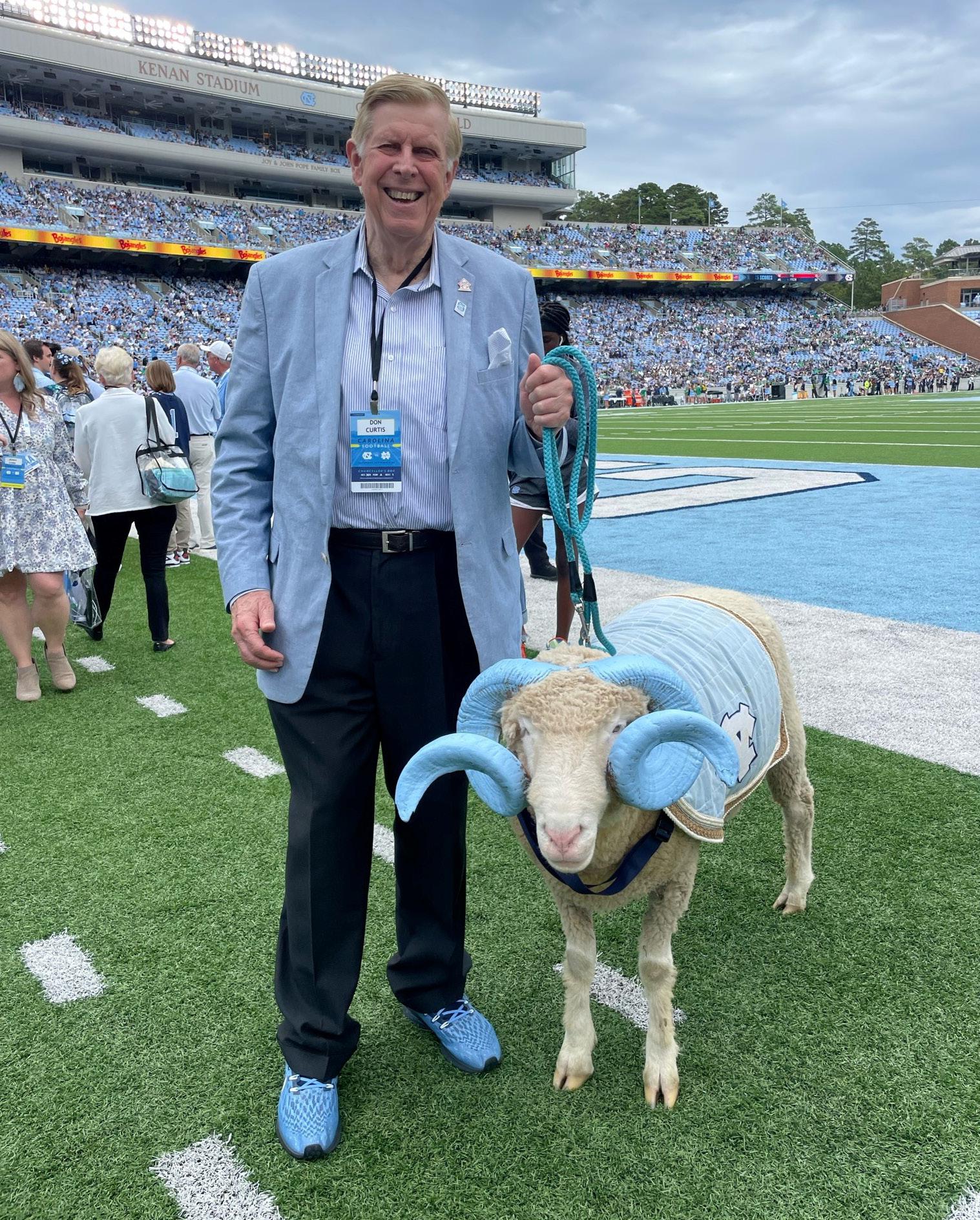
Don Curtis didn’t really notice he even had a Carolina football home game attendance streak until he reached triple digits. It was around that 100 straight home games mark that he decided to start counting … all the way back to 1959, the first game in a streak that remains current and, entering October, had reached 387 straight Tar Heel home games.
That’s over six decades of being in Kenan Stadium every home game Saturday (and the very rare Thursday or Friday). That’s an incredible figure. But what’s even more amazing is that he doesn’t really have any wild tales of events moved to keep the streak alive, or extreme stories of last-minute travel to preserve it.
“The closest I came to missing was during the Covid year,” Curtis says. “But Bubba Cunningham called and said, ‘What are you going to do about the streak?’ I said, ‘Well, I’m just going to miss the game.’ He said, ‘No, you’re not. You have radio stations. You’ll be in the press box.’ And the Tar Heel Sports Network was nice enough to let me be their guest that day.
“It’s absolutely remarkable that I have never gone to a game when I was sick and I’ve never missed a wedding. We came close one time because there was a wedding at 5:00 and the game was scheduled for 3:00. But they moved the game to noon for television. I guess I’ve just had good luck. I’ve always said that when I miss one, I miss one.”
Well, sure … except that he never misses. He’s seen nine different men coach the Tar Heels. He’s seen some very memorable wins— the Giovani Bernard game against NC State in 2012 remains a personal favorite—and a few rough afternoons, too.
Don’t ask him, for example, about a matchup with Air Force in 1966. “It was cold and wet and the field was brown,” he says. “Kenan
didn’t have lights at the time, and this was before cell phones because if I’d had a way to get in touch with the guest I invited, I might not have gone. Air Force had brought their falcon mascot and it was too wet for the band to play, so the halftime entertainment was supposed to be the falcon flying around. The ballgame was so bad that the falcon got out to fly around and left.”
The falcon eventually returned, as did Curtis … game after game after game. But he makes an effort to support Carolina with far more than just his presence at football games. It’s virtually impossible to find any corner of the athletic department or the University as a whole that has been untouched by the Curtis family.
Some of his favorite projects include the Beasley-Curtis Auditorium at Memorial Hall and the Curtis Media Center adjacent to Carroll Hall. It’s fitting for a native of Bessemer City who is a titan of the North Carolina radio and media industries that today’s journalism undergraduates will learn much of the knowledge that will shape their careers in a building that bears his name.
In the world of athletics, his impact is equally generous—and equally widespread. For example, he sat on the bench as a guest of Roy Williams four times during the Williams era thanks to winning bids at charitable events. He good-naturedly notes that he was 4-0 but “made sure not to offer any advice while I was sitting there.”
Curtis’ involvement with the University includes virtually every possible organization. He’s served on The Rams Club Executive Board, been a member of the UNC Board of Trustees, chaired the UNC GAA and served on the Lineberger Comprehensive Cancer Center Board of Visitors. His understanding of enrollment trends caused him to tailor his Rams Club gifts accordingly.
“Fifty-five percent of our enrollment is female,” he says. “It’s very

important that we have a great program for women’s athletics, so that’s where I want my focus to be, with women’s basketball and other women’s sports. As our current enrollment becomes adults and comes back to Chapel Hill and is part of Carolina’s future, we need to do all we can to be sure to keep them fully engaged.”
His generosity has touched multiple programs, but one very tangible example is with his driving the push for a new video board at Carmichael Arena, a venue that hosts multiple teams including women’s basketball.
“Don has such authentic humility and warmth, yet his journey has made him into a real-life superstar,” says women’s basketball coach Courtney Banghart. “In person, he brings comfort and ease, yet his legacy is one of such brilliance and impact…It’s so easy to be a Don fan and thankfully he’s also a true fan of Carolina Athletics. His support of our program is felt by all every day, and his story is a beacon for what Carolina as an institution of learning can do for its students, and in my case, its student-athletes.”
The Curtis legacy will continue long after Don and his wife Barbara, who passed away in 2019 after 52 years of marriage. The couple’s daughter,
Donna, is an active member of the Rams Club Executive Board. One granddaughter just graduated from Carolina and another is a current UNC junior. The Curtis ties to Chapel Hill run for multiple generations, including Don’s father, who was trained as a pharmacist at Carolina.
“Carolina gave me a great education,” Curtis says. “I got a great education that allowed me to make lifetime friends and business associates I do business with. So much of everything good that has happened to me has its origins in Chapel Hill.”
Since he’s very likely seen more of them than anyone else, there was no one better to ask about a perfect fall day than Don Curtis. Relying on the strength of his nearly 400 straight Tar Heel home football games, he provides the following prescription for his perfect fall day at Kenan Stadium:
“I like to get there early to enjoy the pregame activities,” he says. “I like tailgating and socializing. I’d get into the stadium around 15 or 20 minutes before kickoff to see the band come on the field. I’d like the game to be a good football game between two good schools, and hopefully a Carolina win.”

II got my nickname my freshman year. It was the first game I ever started, against Boston College. When I made a tackle, the ESPN announcers started talking about me, and they said Coach Cross had said I was “as aggressive as a bowling ball of butcher knives.”
The whole thing caught on fire, but it was also too much to say all at once. I talked about it with my dad, and we decided to shorten it down to “The Butcher.” Then we incorporated half of my last name and smashed it together, and that’s where we got “Ruck the Butcher.”
I want to have that scary type of mindset on the field. My goal is to win the game. If anyone stands in the way of that, I’m going to make sure they don’t stop me or stop my team. When it gets to game time, the person across from me is nameless and faceless. I have no emotional ties to that person, even if I know him outside the game. On game day, all that matters is winning. It’s a competition, and it’s time to flip that switch.
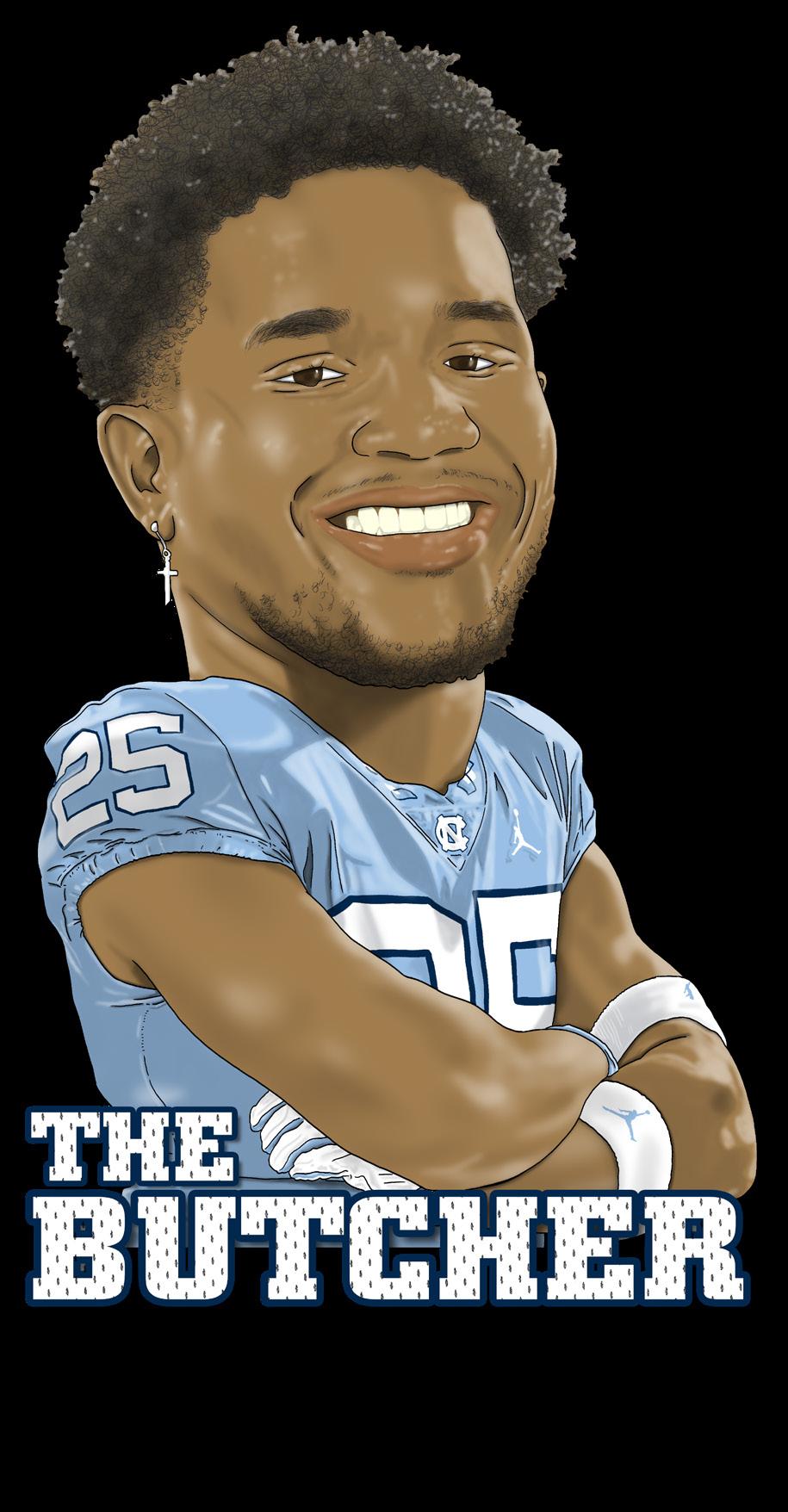
But I never want my contributions on the football field to be my only legacy at the University of North Carolina. I believe that God put me on this earth to serve people, care for people and help others. Football is something I’m good at, but it’s not who I am. I’m someone who wants to be involved in the community, and I love to go out and serve other people.
Growing up,
my parents were involved in a lot of things, and I admired the fact that they had a giving heart and took time out of their busy schedule to help people who might need it. I want to be the same way, because I saw how rewarding it could be to put a smile on the face of someone else.
As a college football player, I know that Carolina has given us a lot. The donors to the Rams Club have given us a lot. We have updates to Kenan Stadium and we have a newly updated players’ lounge. They’ve given to us, and I want to make sure I am giving back.
That’s why I get involved in the community, whether it’s reading to kids or helping out at a field day or being involved with TABLE. Every Friday of home games, I go with my teammates to visit the UNC Children’s Hospital. That brings me back to earth and takes me outside of the bubble where we sometimes live as football players. We are more privileged than so many other members of the community.
That includes the kids and the families at the Children’s Hospital. I know I can’t remove the sickness or disease from them. But hopefully I can try to bring a smile to their faces. Maybe they think it’s cool to meet a football player. Or maybe they just need someone to talk to. So many of the people they see are nurses or doctors who are talking to them about medicine or sticking them with another IV. I want to be another human, another outlet for them who can give them something else to think about for a few minutes.
Being involved in the community humbles me. On gameday, I’m Ruck the Butcher. But ultimately, I hope fans remember me as someone who stands for more than just football.



